#mount kailash 1 history
Explore tagged Tumblr posts
Text
What Makes These Mountains So Mysterious? Exploring the Hidden Secrets
What Makes These Mountains So Mysterious? Exploring the Hidden Secrets https://www.youtube.com/watch?v=fOof5HJIQBw What Makes These Mountains So Mysterious? Mysteries of the world's most enigmatic mountains. We delve into the legends and myths surrounding sacred peaks and uncover the geological wonders that make these mountains unique. From strange formations to extreme weather phenomena, explore how these natural wonders have fascinated explorers and scientists alike. Learn about the hidden secrets and spiritual significance of famous mountains. #MysteriousMountains #MountainLegends #geologicalwonders Chapters: 00:00 - Introduction 00:17 - Mount Kailash 01:16 - Mount Everest 02:11 - Devil's Tower 03:18 - Mount Roraima 04:25 - Dyatlov Pass 05:34 - Mount Ararat 06:31 - Mount Fuji 🔔 Join Timee Travel Tales to watch more content on history, mystery, ancient civilizations, forbidden secrets and shocking truths: https://www.youtube.com/@TimeeTravel-Tales?sub_confirmation=1 ✅ Stay Connected To Us. 👉 Twitter: https://ift.tt/7ikLtlJ ============================= ✅ Recommended Playlists: 👉 Historical Mysteries: https://www.youtube.com/playlist?list=PLse1rwd1X1NS-WCac0iuAj3ybRtUTip4S ✅ Other Videos You Might Be Interested In Watching: 👉 Mind-Blowing: Top 5 Most Bizarre Ancient Cultures in the World https://www.youtube.com/watch?v=Fbq-m7x6wCs 👉 10 Archaeological Discoveries That Could Rewrite History https://www.youtube.com/watch?v=nBEHjQMFyLU 👉 Mind-Blowing! The Top 5 Life-Changing Inventions Ever Created https://www.youtube.com/watch?v=PCRtDnFXo_g 👉 The African Scientist They Don't Want You To Know About https://www.youtube.com/watch?v=6Jw8z7IA234 ================================ ✅ About Timee Travel Tales: Discover the secrets of ancient history with "Time Travel-Tales with Aoron Rey, a YouTube channel dedicated to unraveling the mysteries of lost civilizations, ancient technologies and the myths and legends that have captivated humanity for centuries. Our engaging history storytelling brings the past to life, offering history enthusiasts a unique opportunity to explore the rich tapestry of human history through vivid narratives and expert insights. Join Aoron Rey as he guides you through engaging history content from the rise and fall of civilizations to the incredible inventions and ideas that have shaped our world. Whether you're interested in the ancient world, looking to dive deep into the stories of historical figures and events or simply curious about the origins of myths and legends, "TimeeTravel-Tales" is your go-to source for all things history. Welcome aboard Timee Travel-Tales – where history comes alive! 🔔 Hit that subscribe button for more Detailed explorations of the world's most mysterious places: https://www.youtube.com/@TimeeTravel-Tales?sub_confirmation=1 ================================= Disclaimer: We do not accept any liability for any loss or damage incurred by you acting or not acting as a result of watching any of our publications. You acknowledge that you use the information we provide at your own risk. Do your own research. Copyright Notice: This video and our YouTube channel contain dialogue, music, and images that are the property of the Timee Travel Tales. You are authorized to share the video link and channel and embed this video in your website or others as long as a link back to our YouTube channel is provided. © Timee Travel Tales via Timee Travel Tales https://www.youtube.com/channel/UCg1VIk-yWsZSmbuJyJA5_TQ September 01, 2024 at 07:30PM
#historicalanalysis#unbelievablestories#amazingrealities#hiddentreasures#ancientwealth#archaeology#historicaldiscoveries#travelwarnings
0 notes
Text
This [The fantasy Map of India in Immortals of Meluha] is a fairly common addition to texts published in the fantasy fiction genre, particularly since it attempts to construct a world whole-cloth for uninitiated readers. Unlike a standard map, the visual technology behind this one is slightly different: it is not part of the colonial project that enables mastery. Instead, this is a map that is deliberately attempting to reimagine a past for the country – reconstructing the territory along fantastical lines that allow the author full freedom over the world of the text. While analysing the iconography associated with the geobody of India, Ramaswamy discusses the “enchanted cartographies” that come to define Bharat Mata. This is a slightly different project: the map is attempting to lay claim to the imaginative space of a fantastical India. This is an India that never was and would never be – but it could be. The text is laying claim to the very possibilities that fantasy represents, and through the image of the map, allows a kind of dominance over the space of the world.
Ramaswamy has noted in her essay that cartographies of this order engender a specific kind of male citizenship, that later changes into iconography that imagines the country as female. That The Shiva Trilogy (and a large number of texts in the fantasy fiction genre) relies on the trope of the promised king says a lot about the mastery that is demanded on this imaginary land. Nor is it an accident that a Hindu God is reimagined for this role. Tripathi’s own leanings towards a pro-Hindutva politics aside, fantasy has long been a repository for right of centre politics. Carroll’s essay contains, perhaps the most succinct analysis of this phenomenon: “Many fascist intellectuals believe that time is cyclical or nonlinear, which means that archaic elements from previous eras might recur again once more when the present epoch is over. Frequently the alt-right draws upon popular media set in ancient history or pseudo-medieval fantasy worlds to try to convey what this might look like. The alt-right fights so hard over these genres because they want to lay claim to imagination’s potential to transcend the here and now” (Carroll).
The question, then, is what kind of world order is the text of The Shiva Trilogy imagining? There is no doubt that the text of the novel posits the grand attempt at civilisation that is Meluha (in itself a very masculine endeavour) as the correct mode of existence. Shiva, coming from mount Kailash and having lived in a homeland that supposedly is caught in strife, says, “‘The tribes in my homeland were no better than animals. They didn’t even want to live a better life!’” (Tripathi 110). And the civilisation with the correct moral order is a Hindu one. There is little to no conversation about this fantasy land being secular or not: this is a world order that is pre-secular to begin with. What requires correction are the hierarchies found in modern Hinduism, which have been reimagined in inventive ways. In this world order, “Tribal” people such as Shiva are easily assimilated into the mould of Hinduism, with some of their traditions and Gods being posited as having been sourced in Upper Caste Hinduism to begin with. For instance, when Shiva describes the concept of Shakti (apparently a common philosophical belief amongst his people), a surprised Brahaspati comments, “‘Interesting. That word has not been used to describe energy for many centuries. It was a term of the Pandyas, the ancestors of all the people of India. Do you know where your tribe came from? Their lineage?’” (Tripathi 74).
In many ways, this hints at a common past for all the socio-religious identities of India. This is a Hindu project, and that it has seen resonances in other texts published in India (see footnote 1) only speaks to a certain kind of anxiety that demands this elaborate reconstruction of India.
- The Promised King: Rewriting India and Other Masculine Fantasies in Indian Publishing
#figured might as well show u all a draft of my paper#since this is the premier literary salon etc etc#also i'm working on a paper i genuinely care about after so so so long#hello void this is ridiculosity#the shiva trilogy#immortals of meluha#amish tripathi#i talk about books for the hundredth time like its a new thing#Some of this is definitely going to get edited out#Because the course is on masculinity so I'll be forced to have a tighter focus#But anyway here's a draft just for you#south asian writing#south asian science fiction#south asian fantasy#hindutva#sff
23 notes
·
View notes
Text
Miraculous World intro analysis: Locations of the other Miracle boxes
In the (freaking awesome) new intro of the New York special we saw a glimpse of Miraculous’ future plans after Marinettes Miracle Box gets showcased.

The glowing location points are all the miracle boxes that can be seen from this view and will probably have some kind of importance in future projects. The world map is actually pretty accurate even if not 100% perfect at points which I will forgive since it does its job more than fine.
So I tried making out the locations and these are my results:
For the start two general overview maps:
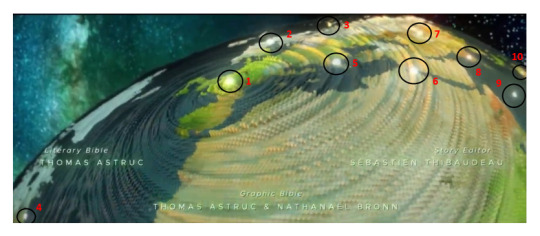

The way I saw it I made out 10 points in the intro shot. There will very likely be more to come because I interpreted the intro the way that with each new project of Ml World we will see not only more of the Ladybug and Chat Noir statues, we will also see more and more views over the world showing us more location points along the way.
Now let's dive a little deeper into the world map to get a bit of a better look what these locations are
If this will actually be the case (which I hope) then I will probably keep on adding them to my world map here to provide an updated version just so we all can keep track xD
Locations 1 - 3
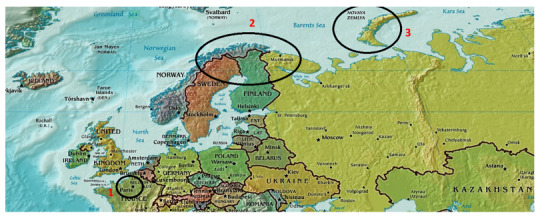
I dont think location 1: Paris needs any kind of explaination, so moving on to location 2: Scandinavian. Here is one of the instances where the intro world is simply not accurate enough to really tell what location they meant. With every other point I found a capital city or something like that right at the location they showed, but not here. I cant imagine it being the city Murmansk because location 3: Novaya Zemlya is already part of Russia so the 2. point being somewhere in the upper part of Scandinavia, where Norway, Sweden and Finland meet, is much more likely in my opinien, because it would also give them another very popular culture to explore in Miraculous. I’m just not sure in which country to place it, therefore I’ll leave it as Scandinavia for now.
Location 4
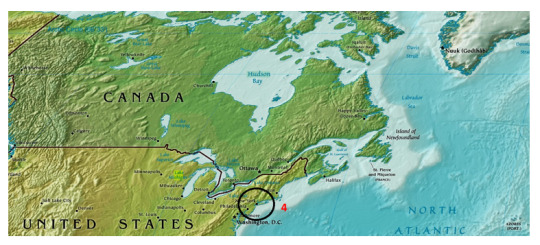
Another very simple one since it is literally the location of this very special. Location 4: New York.
Locations 5 - 7
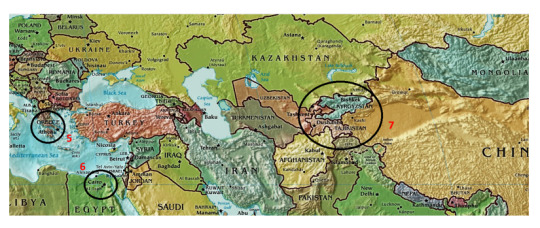
Now things start to get really interesting, because location 5 is Athens and location 6 is Cairo. Both Greece and Egypt are already comfirmed as places with Miraculous history in the Show (”The Pharaoh” for Egypt and the beginnings hero montage of “Origins 1″ for Greece since it shows Hercules for example as a miraculous holder which is also comfirmed by Alya in “Feast”), so I’m very excited to see what we will discover there!
Location 7 is like 2: Scandinavia a bit tricky to make out because without a better angle to look at it the glowing point could be located on both Kyrgyzstan or Tajikistan. And since for now I have no way of narrowing it down any other way, I will leave it like this as well.
Location 10
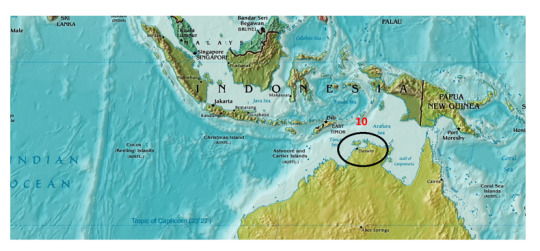
I’m doing location 10: Darwin before 8 and 9 because I havent noticed any forshadowing or hints towards Australia in anything Miraculous related and therefore I dont have anything to say on this one besides that I find the idea of a Miraculous special in Australia pretty damn awesome. And I wanna add that I find the chosen location in Australia quite suspicious, this is connected to something, I can feel it. I dont know what it could be but I will figure it out.
But now lets take a look atthe last two and by FAR my favorite ones of them all!
Locations 8 & 9
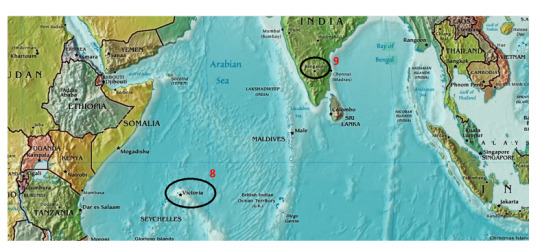
Location 8: Victoria is VERY interesting in my opinion and made me squeal of excitment because it is located on one of the places where Atlantis is speculated to have been. Atlantis was comfirmed to us in “Style Queen” to have actually existed in the Ml universe before it was sunken by Plagg. So the island Victoria to be a place the Miraculous World has future plans with is just too good to be true. That could be the Ml project we get to explore Atlantis, how amazing is that? :D
And last but definitely not least, location 9: Bangalore. THIS one made me so happy once I realized the connection, I am BEAMING! Because Bangalore is near the Ellora Caves which people who read my Guardian Mountain - Mount Kailash theory would know as the Kailasa Temple. We may actually be onto something here guys, this stuff is getting better and better and I am so hyped for ALL of this! Bring it on Miraculous World, I’m ready for you!
Alright guys so for now this is it. Here is an overview map of the locations I just covered and hopefully we will have alot more to add in future :D
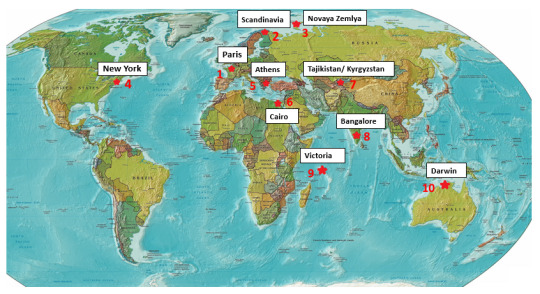
Oh and @chicoriii I’m just gonna tag you right away, I think you wanna see this ;D
#miraculous#miraculous ladybug#ml spoilers#ml new york special#Miraculous World#ml analysis#ml theory#Guys this gonna be SO good#ml sugar#Miraculous world spoilers#God I love this show#What a time to be a nerd
450 notes
·
View notes
Text
Ganesh Chaturthi Whatsapp Status in Marathi Hindi English
is one of the most popular 10-day festivities (ISO: Gaṇeśa Chaturthī), otherwise called Vinayaka Chaturthi (Vināyaka Chaturthī), is a Hindu celebration praising the appearance of Lord Ganesh to earth from Kailash Parvat with his mom Goddess Parvati/Gauri. The celebration is set apart with the establishment of Ganesh dirt icons secretly in homes, or freely on expound pandals (brief stages). Perceptions incorporate reciting of Vedic songs and Hindu messages, for example, petitions and brata (fasting).[3] Offerings and prasadam from the day by day supplications, that are conveyed from the pandal to the network, incorporate desserts, for example, modaka as it is accepted to be a most loved of Lord Ganesh.[4][5] The celebration closes on the tenth day after beginning, when the symbol is conveyed in an open parade with music and gathering reciting, at that point drenched in a close by waterway, for example, a stream or ocean. In Mumbai alone, around 150,000 sculptures are submerged annually.[6] Thereafter the mud icon breaks down and Ganesh is accepted to come back to Mount Kailash to Parvati and Shiva.[3][7] The celebration observes Lord Ganesh as the God of New Beginnings and the Remover of Obstacles just as the divine force of insight and intelligence[8][9] and is watched all through India, particularly in the states, for example, Maharashtra, Goa, Karnataka, Madhya Pradesh, Andhra Pradesh, Kerala, Telangana, Odisha, West Bengal, Gujarat and Chhattisgarh,[3][10] and is normally praised secretly at home in Tamil Nadu.[11] Ganesh Chaturthi is likewise seen in Nepal and by the Hindu diaspora somewhere else, for example, in Australia, New Zealand, Canada, Malaysia, Trinidad and Tobago, Guyana, Suriname, different pieces of the Caribbean, Fiji, Mauritius, South Africa,[12] United States, and Europe[7][13][14]
At open settings, alongside the perusing of writings and gathering devouring, athletic and hand to hand fighting rivalries are likewise held.[15]
Substance
1 History
1.1 Ganesh
1.2 Festival
2 Celebration in India
2.1 At unmistakable sanctuaries
2.2 At home
3 Celebration Outside India
4 Foods
5 Environmental effect
6 Gallery
7 See moreover
8 Notes
9 References
9.1 Bibliography
History
Ganesha, Basohli small scale, around 1730.
It is obscure when the celebration began. It turned into a significant social and open occasion with sponsorship of Shivaji after Mughal-Maratha wars. It became mainstream again in the nineteenth century after open intrigue by Indian political dissident Lokmanya Tilak,[16] who advocated it as a way to bypass the pioneer British government restriction on Hindu social affairs through its enemy of open get together enactment in 1892.[17][18][11]
Ganesh
Additional data: Ganesh
In spite of the fact that not insinuating the traditional type of Ganapati,the most punctual notice of Ganapati is found in the Rigveda. It shows up twice in the Rigveda, once in song 2.23.1, just as in psalm 10.112.9.[19][20][21] Both of these songs infer a job of Ganapati as "the soothsayer among the diviners, flourishing incalculable in food directing among the older folks and being the ruler of summon", while the psalm in mandala 10 expresses that without Ganapati "nothing close by or a far distance is performed without thee", as per Michael.[19][22] However, it is questionable that the Vedic expression Ganapati which truly signifies "watchman of the hoards", alluded explicitly to later time Ganesh, nor do the Vedic writings notice Ganesh Chaturthi.[23] shows up in post-Vedic messages, for example, the Grhya Sutras and from that point old Sanskrit messages, for example, the Vajasaneyi Samhita, the Yajnavalkya Smriti and the Mahabharata notice Ganapati as Ganesvaras and Vinayak. Ganesh shows up in the medieval Puranas as "lord of progress, impediment remover". The Skanda Purana, Narada Purana and the Brahma Vaivarta Purana, specifically, bountifully acclaim him.[24] Beyond printed translations, archeological and epigraphical proof propose Ganesh had gotten famous, was adored before the eighth century CE and various pictures of him are detectable to the seventh century or prior.
Ganesh symbol in Khairatabad, Hyderabad, India
For instance, carvings at Hindu, Buddhist, and Jain sanctuaries, for example, at the Ellora Caves, dated between the fifth and eighth century show Ganesh respectfully situated with significant Hindu goddess (Shakti).[25]
Celebration
In spite of the fact that it is obscure when (or how) Ganesh Chaturthi was first observed,[26] the celebration has been openly celebrated in Pune since the time of Shivaji (1630–1680, author of the Maratha Empire).[26] After the beginning of the British Raj, the Ganesh celebration lost state support and turned into a private family festivity in Maharashtra until its recovery by Indian political dissident and social reformer Lokmanya Tilak.[26]
I followed with the best interest swarms who conveyed in parade an interminable number of icons of the god Ganesh. Every little quarter of the town, every family with its followers, every little city intersection I may nearly say, arranges its very own parade, and the most unfortunate might be seen carrying on a basic board their little icon or of papier mâché... A group, pretty much various, goes with the icon, applauding and raises cries of happiness, while a little ensemble by and large goes before the symbol.
– Angelo de Gubernatis, Bombay Gazette (1886)[27][28]
As per others, for example, Kaur, the celebration turned into an open occasion later, in 1892 when Bhausaheb Laxman Javale (otherwise called Bhau Rangari), introduced the first sarvajanik (open) Ganesh icon in Pune.[29] In 1893, the Indian political dissident Lokmanya Tilak adulated the festival of Sarvajanik Ganesh Utsav in his paper, Kesari, and devoted his endeavors to dispatch the yearly local celebration into a huge, efficient open event.[30] Tilak perceived Ganesh's intrigue as "the god for everybody",[31] and as indicated by Robert Brown, he picked Ganesh as the god that overcame "the issue among Brahmins and non-Brahmins", consequently assembling a grassroots solidarity across them to contradict British frontier rule.[32]
Different researchers express that the British Empire, after 1870 out of dread of subversive congregations, had passed a progression of statutes that restricted open gathering for social and political reasons for in excess of 20 individuals in British India, however excluded strict get together for Friday mosque petitions under tension from the Indian Muslim people group. Tilak accepted this successfully hindered the open get together of Hindus whose religion didn't command every day petitions or week by week social affairs, and he utilized this strict exception to make Ganesh Chaturthi to dodge the British pioneer law on huge open assembly.[16][17][11] He was the first to introduce huge open pictures of Ganesh in structures in Bombay Presidency, and other celebratory occasions at the festival.[33][note 1]
God Ganesh: political impediment remover
Is there any good reason why we shouldn't change over the huge strict celebrations
into mass political assemblies?
— Lokmanya Tilak, Kesari, 8 September 1896[38]
As per Richard Cashman, Tilak enrolled and enthusiastically invested in god Ganesh after the 1893 Hindu-Muslim common brutality in Bombay and the Deccan riots, when he felt that the British India government under Lord Harris had more than once favored one side and not treated Hindus decently on the grounds that Hindus were not well organised.[39] In Tilak's gauge, Ganesh love and parades were at that point mainstream in provincial and urban Hindu populaces, across social stations and classes in Baroda, Gwalior, Pune and the vast majority of the Maratha locale in the eighteenth century.[40] In 1893, Tilak extended Ganesh Chaturthi celebration into a mass network occasion and a concealed methods for political activism, scholarly talk, verse presentations, plays, shows, and people dances.[41]
In Goa, Ganesh Chaturthi originates before the Kadamba time. The Goa Inquisition had prohibited Hindu celebrations, and Hindus who didn't change over to Christianity were seriously confined. Be that as it may, Hindu Goans kept on rehearsing their religion in spite of the limitations. Numerous families love Ganesh as patri (leaves utilized for adoring Ganesh or different divine beings), an image is drawn on paper or little silver icons. In certain families Ganesh icons are covered up, an element extraordinary to Ganesh Chaturthi in Goa because of a prohibition on dirt Ganes symbols and celebrations by the Jesuits as a feature of the Inquisition.[42]
Festivities
Man painting a sculpture of Ganesh
Craftsman setting up Ganesh's picture for the celebration in Margao, Goa
The Laalbaaghcha Raja (the most eminent variant of Ganesh in Mumbai) in parade.
Open arrangements for the merriments start a very long time ahead of time. Nearby Mandapa or Pandal's are typically subsidized either from gifts by neighborhood occupants or facilitated by organizations or network associations. The creation of the Murti in Maharashtra for the most part starts with "Padya pooja" or loving the feet of Lord Ganesh. The Murti's are brought to "pandals" on the day or a day prior to the celebration starts. The pandals have expound embellishment and lighting.
At home, the celebration readiness incorporates buys, for example, puja things or adornments a couple of days ahead of time and booking the Ganesh murti as right on time as a month previously (from nearby craftsmans). The murti is brought home either a day prior or upon the arrival of the Ganesh Chaturthi itself. Families enhance a little, clean part of the house with blossoms and other bright things before introducing the icon. At the point when the Murti is introduced, it and its sanctuary are enlivened with blossoms and different materials. Upon the arrival of the celebration, The stately establishment of the earth murti (icon) is done alongside serenades of blessed mantras and pooja including bhajans during a specific favorable time of the day.
In anticipation of the celebration, craftsmans make earth models of Ganesh available to be purchased. The Murti's range in size from 3⁄4 inch (1.9 cm) for homes to more than 70 ft (21 m) for huge network celebrations.[43]
The date for the celebration is normally chosen by the nearness of Chaturthi Thithi. The celebration is held during "Bhadrapada Madyahanaa Purvabaddha". In the event that the Chaturthi Thiti starts around evening time
1 note
·
View note
Text
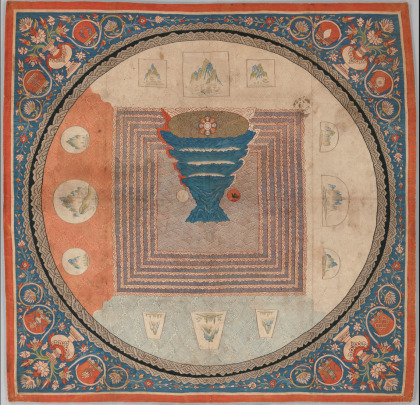
THE HEAVENLY LOCALES HIDDEN UPON AN ALTER-EARTH, OR ARE DISGUISED UPON THE PLANET
All religions hold a variation of the belief in an earthly counterpart to paradise. Judging by the psychonautical guidebooks and accounts of journeys to these sanctuaries, the amount of physical determination required makes a K2 climb look like a jog around the block.
But the promise of release from the conditions of physical landscape and even corporeality is more than a term in the contract; its possibility should already exist embryonically within the traveler, who seeks “spiritual riches.”
The chronology of the journey is circular, and the destination found to have been moving and “home” all along: There is no geographical cure, there is no chronological cure.
These are journeys to special places the pilgrim may be unsure even physically exist—and their faith therefore must be even stronger than those who think themselves comfortably saved in the big-ticket religions. Mecca and Lourdes and Jerusalem and Mount Kailash and Bodh Gaya are right there, in two dimensions, on a map or book page. One can make the trek to visit them.
These places, in contrast, seem half-products of imagination: glimpsed through mists, glinting on mountaintops or in valley shadows, temporary refuges, or—so it is told—promising more than just salvation or immortality.
They involve in one fashion or another a return to the origin, to the founder, to the creator, to the center of the cosmos.
It is difficult to determine the spiritual pilgrimage’s arrow of signification when it comes to physical geography vs. entheogeography (to meet deity or salvation via a hidden landscape). Rene Guenon and others believe that an otherworldly itinerary always precedes and is the model for that of a transfigured earth; the plane of the lower always symbolizes the higher, and never the opposite.
To undergo a difficult journey to a place of transcendence, transfiguration, or salvation is always held under secular or profane conditions, simply because to travel “across, into, within” remains conditioned by the Cartesian extensional/dimensional realms of human perception. One can travel from one’s own prayer mat given the proper physical and mental training, and with the right secretions of the “celestial dew,” won by years of practice, visions of paradise can douse the mind into ecstatic communion.
For the rest of us, we can hope to find a sacred landscape and its disguised architecture and residents.
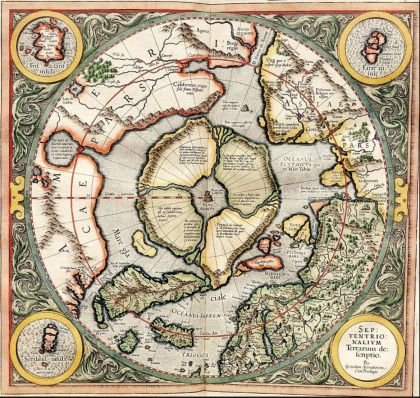
MOUNT MERU/AGARTTHA
According to Guenon, the “primordial tradition” of all spiritualities and religions is focused around the concept of the Source or Pole about which all events turn in a cyclical manner.
The most explicit of these is shown in the 7-stage cycle of a kalpa, which is broken down into 14 manvantaras. Each manvantara contains 7 yugas or ages. The manvantara signifies a degeneration and regeneration of energy and its manifestations in truth.
We are currently in the yuga of Kali, in which destruction of the tradition (and thus the destruction of truth) accelerates. The long decline is followed by a purification and renewal.
All these cycles move about the primordial pole, Mount Meru. Meru is believed to have been at the northernmost part of the world and connected the earth to the heavens by means of the Pole star.
Although holy mountains occur in nearly every religion, Guenon and other traditionalists believe Meru is the archetype, and was constituted tens of thousands of years ago as the symbol of this manvantara. Thus, in one sense, all other holy mountains are emanations of Meru, and physical journeys to them are substitutes for the true Meru in a secondary, “profane” sense.
Meru is reflected in our secular concepts of the physical North Pole and the magnetic poles. The self-generating energies, as bases for all cyclical activity, as found in Asian religions, have been corrupted as they moved South and West; they become linear time construed as the primary or only kind of time.
Taken together, these two “types” of time form the basis for the symbol of the cross: the vertical signifying the revivifying Pole (infinite perception/life) and the horizontal signifying linear, finite perception.
“Dual time” is thus symbolized, reflecting simultaneously the four cardinal directions, the heavens above, the earth beneath, and the point (the center) as conceived as a single individual person standing on the face of the planet. We are all therefore at this center, ignorant though we are of it. The swastika adds to the cross a sense of motion as all cosmic and human events flow around the Pole.
To Guenon, (in his book The King of the World), the Pole’s main emanation was the kingdom of Agarttha, a civilization that long ago openly manifested the principles of these cycles. Its king was both legislator and the embodied truth of the cycles and, again, was represented by the cross.
Over the degeneration inherent in successive yugas, Agarttha withdrew into obscurity, leaving reflective centers of its wisdom in chosen persons and hidden social orders that preserved its truths and teachings.
By now, the Kali-yuga, Agarttha is underground in both literal and metaphoric senses. Thus, those seekers who strike out on the road for true knowledge and understanding of the earth, of deity, of immortality, or of humanity’s place in the cosmos in a “place learned in ancient hidden ways” are all seeking Agarttha in a metaphorical sense.
Each act of substitution, whether it be soma instead of Haoma, — instead of amanita, a piece of transubstantiated bread in place of Jesus’s flesh, wine in place of his blood, is a recapitulation of the primordial loss to our current reflective centers (our religions/esoteric schools) and the replacement of our linear time to Agartthan cyclical principles and centeredness.
HYPERBOREA
For Guenon, Hyperborea is the land beneath the geographic North Pole, with the arktoi, the Little Bear and Large Bear, as the symbols and guardians of the world axis.
From these asterism’s motion about the pole star comes the symbolic swastika, with its implied motion of the stars at the four ends of the cross. Mount Meru is always used as an evocation of this lost paradise of the Golden Age beneath a perfectly circling celestial dome. The Golden Age was less associated with a physical place then a principle that held for the world—although Guenon constantly hints at a geographically-situated actual civilization at the pole, which obviously has since sunk or was a landscape now obscured to history due to a pole shift.
The ancient Greeks were split as to Hyperborea’s location, only that it was far north of the Mediterranean civilizations. Herakles’s third labor involved traveling to the Northernmost land to capture what scholars have interpreted as a reindeer—an animal indigenous to Siberia, of course. This “golden horned hind” was sacred to Artemis. Britain, the Urals, and the land beyond the Riphean mountains all were candidates for its physical location. Hecataeus claimed the sun rose and set only once a year in Hyperborea, placing it therefore above the Arctic Circle.
Such terra incognita furnished a template for legends such as those saying Apollo spend part of the year in Hyperborea–which is fitting for a god who was mysteriously venerated both as the sun and of the long chthonic darkness of the polar winter (in his aspect as master of the caves’ “sleep temples”). Both Herodotus and Platomentioned Abaris, the Hyperborean healer who was probably from Scythia (the Ukraine or possibly even farther north in Siberia).
A variant is Ultima Thule, which a mariner merchant name and Pytheas claimed to have visited solo in the fourth century BCE, possibly Norway but was more likely England, Brittany, or even Iceland.

PARDES
The Garden of Eden is traditionally identified as being somewhere in Mesopotamia at the confluence of four great rivers (two of whose identities, the Tigris and Euphrates, are well obviously known) within ancient Sumer and Babylon. In the 3rd century Tosefta or gloss on the Torah’s Mishnah (oral tradition) is told the story of four rabbis who stumble into an otherworldly garden called PARDES. Only one of the rabbis, Akiva, survived this incursion and was able to tell the tale; one went insane, one died, and the fourth became a heretic. Over time, PARDES eventually came to symbolize both a place on earth and a place in, or of, the seven heavens (the latter idea which was probably adapted from Babylonian religion during the captivity).
As one interpretive tradition tells it, the loss of the physical Temple in Jerusalem in 70CE necessitated creating a spiritual Temple accessible through ritual means. Some of these means are preserved in the hekhalot (palace) and merkavah (chariot-throne) rituals conveyed in both Qabbalah and further Mishnah traditions.[1]
Both are said to have originated in the prophet Ezekiel’s vision of YAHWEH’s chariot/throne and its four guardians centuries earlier.
Ezekiel’s status as a priest and prophet during the Babylonian captivity allowed him to disseminate the idea that the Temple traditions and the Hebrew faith could be carried on while in exile, without the physical location or implements in Jerusalem. This led to practices of internalizing imagery as a substitute for the lost Temple.
BABYLONIAN INFLUENCE
As a Babylonian exile, Ezekiel was on the banks of the Chebar River when his divine encounter occurred out of the north. In this context, as we’ve seen in the primordial Hindu tradition, north symbolizes the pole or center of the world—Meru. Some believe the vision incorporates Babylonian beliefs, and through those, the Sumerian astrotheology which preceded it—specifically the paths of the gods Anu, Enlil, and Ea and Enki. Enlil’s path is the 12 to 30° celestial north, around the pole star, and the Great Bear was considered the “great wagon” by the Sumerians: MAR.GID.DA. In Greek, this was AMAXA, or the chariot.
After a Sumerian or Babylonian statue of a god was charged and consecrated, its mouth washed and opened,[2]it was transportable. Its essence came from the stars. The essence is me and is the gift of civilization that Inanna stole from Enki.
Charged Babylonian statues were certainly brought to the river Chebar, where Ezekiel’s vision apparently begins, to end the rituals. Further it has been speculated that he was on the banks of the canal connecting Babylon to the holy city of Nippur where the mountain palace of Ekur, the home of Enlil, sat. His vision of the four companion beings conforms to the Sumerian griffins.
Both chariot and throne traditions utilize rhetoric of ascent or descent to the chariot/throne; in fact, the interchangeable double-use of these terms may be a clue as to the meaning, in the sense that the road upward and the road downward are the same, as Heraclitus said—that is, in the ritually altered states of mind of approach, conventional dualities and identity drops away: throne/chariot, ascent/descent, ritual aspirant/angel, ritual aspirant/apotheosis.
The path of Ea was comprised of 15 stars, with Regulus being dominant. AB.ZU. The abyss of Enki was the first star appearing in the constellation of the Libra, at the vernal equinox, the entry to the underworld.
THE RING OF QAF
Muhammad al-Kisa’i mentions the realm of Qaf in his hadiths of the Prophet. It figures in the geography of Ibn Fadl al-Humari’s Pathways of Vision in the Realms of the Metropolises (1340CE). According to al-Kisa’i’s Prophet Muhammad, Qaf is the primordial mountain, like Meru, of which all our sensible ones are just emanations. It is home of the phoenix and land of the “hidden people”—the Jinn. Muhammad had visited it on his Mi’raj. The Qaf Mountains are made of emerald or peridot and “gave birth” to all mountains on earth, which are connected by underground/submarine passages not unlike arteries. Qaf is said to encircle the earth but is protected from humans by the oceans of the world. Here the narrative echoes that of Olympus and the fairies’ Avalon, as well as the Hindu-Buddhist realm of Shambhala, the abode of the blessed, which is situated similarly in an impassable mountain range that rings 96 towns.
Mythology scholar Thomas Keightly (1789-1872) also recounts Persian explorer Hatim Tai’s account of Qaf, describing lush provinces of magical “technologies.” Hatim’s “Djinnestan” holds two mysterious cities, Jabulqa and Jabulsa. In Al-Kisa’i’s hadith, Muhammad said that the twin cities’ exclusively male inhabitants lived in a continuous green twilight and knew nothing of the human world.[3] The Prophet declared it would take forty months’ journey in total darkness to reach these emerald cities…Perhaps this means a semi-permanent hypnagogic state of consciousness “suspended” for such a period, through ritual sensory deprivation techniques?
HURQALYA
Henry Corbin’s Spiritual Body and Celestial Earth describes the relationship between two major strands of Iranian spirituality: the Zoroastrian Zend-Avestas and the Shi’ite ta’wil of Sufi ecstatic Shahib Suhrawardi (1154-1191CE) and Sunni philosopher Ibn Arabi (1165-1240CE).
A journey to break the membrane into the archetypal world could begin anywhere, with a meditation upon anything—but it is much easier if one starts with one’s being in a world of light.
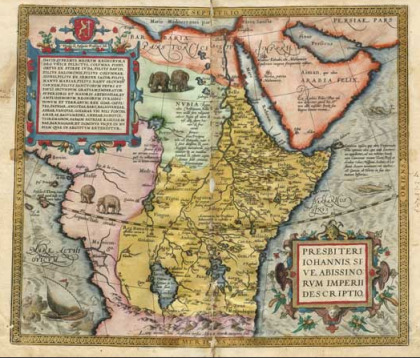
THE KINGDOM OF PRESBYTER JOHN
Our magnificence dominates the three Indias, and extends to farther India, where the body of St. Thomas the Apostle rests. It reaches through the desert toward the place of the rising of the sun, and continues through the valley of deserted Babylon close by the Tower of Babel. 72 provinces obey us, and a few of which are Christian provinces; and each has its own king. And all their kings are our tributaries…In our territories are found elephants, dromedaries, and camels, and almost every kind a beast that is under heaven. Honey flows in our land, and milk everywhere abounds. In one of our territories no poison can do harm and no noisy frog croaks, no scorpions are there, no serpents creep through the grass. No venomous reptiles can exist there or use their deadly power.
In one of the heathen provinces flows a river called the Physon, which, emerging from Paradise, winds and wanders through the entire province; and in it are found emeralds, sapphires, carbuncles, topazes, chrysolites, onyxes, beryls, sardonyxes, and many other precious stones. During each month we are served at our table by seven Kings, each in his turn, by 62 Dukes, and by 365 counts, aside from those who carry out various tasks on our account. In our hall there dine daily, on the right hand, 12 archbishops, and on our left, 20 bishops, and also the patriarch of St. Thomas, the Protopapas of Samarkand, and the Archprotopapas of Susa, in which city the throne of our glory and are Imperial Palace are situated.
If you can count the stars of the sky and the sands of the sea, you will be able to judge there by the vastness of our realm and our power.
This is a 19th century reconstruction[4] of the letter sent by “John the Priest-King” (the Presbyter John or Prester Jean) to Emperor Manuel Comnenus in 1165. There had been rumors for decades during the medieval period about a mysterious Magi priest-king in the East who was invincible. His legend preceded this letter, and the Emperor believed that it clinched Jean’s existence. And Jean’s help was needed by the crusaders stuck in Antioch and Edessa.
Later, a bishop named Hugh brought word of the situation in the Holy Land and the priest-king Jean’s victories against the Saracens to Pope Alexander III in 1177. Hugh claimed Jean would already have swept the Muslims from the Holy Lands but for his army’s inability to cross the Tigris (which is odd for an almost supernatural being like Jean and his hosts; it’s almost as if the Tigris water was anathema to him and his army, some sort of forbidden barrier they couldn’t cross by a form of magic).
The Pope and his advisors wanted to believe in Jean. They knew that Nestorian Christians lived in Persia and India and even China and thus believed Jean to be a Nestorian king. (Nestorius was a fourth century cleric who believed Jesus was an ordinary human who grew into his divinity. This got him booted from Rome at the council of Nicaea, along with a lot of other heretics. Nestorius and his followers then moved further eastward under Byzantine then Muslim protection.) Jean’s denominational beliefs made no difference to Rome after the disaster of the Seljuk raids on Edessa and Antioch. They needed all the help they could get. So when Hugh presented this “intelligence” that Jean was not invincible, and had been basically defeated by the Tigris, the Pope gave up beseeching him for help and called for the second crusade.
Still, Alexander III believed Hugh’s tale so much that he sent his personal physician Philip to search for Jean. Philip is never mentioned again in the historical record, but the letter apparently continued to circulate with more and more fantastic embellishments—the prototypical hypertextual story of a superhero.
Jean’s emerald scepter connects him in a tangential possible way with Hermes Trismegistus, whose “eternal philosophy” was written upon an emerald tablet.
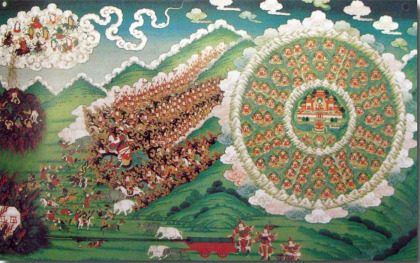
SHAMBHALA
There are four main Tibetan texts describing journeys to the paradise of Shambhala. They are mostly based on long-lost earlier texts and have the character of dream trips or visions. The four are:
—Shambhalai Lamyig (Description of the Way to Shambhala) authored in 1775 by the third Panchen Lama of the — sect. This is considered the “standard text” of the journey, because it is based upon an earlier version that is a part of the Tengyur, a long commentary on the Tibetan canon. The account was translated into Tibetan a century earlier by the scholar Taranatha, and is called The Entrance to Kalapa. Kalapa was the capital of Shambhala and seat of its king. The Panchen Lama’s introduction also mentions a guidebook written by a Menlung Lama, who received the instruction via a dream; its route north required two or three years and led north through the Uighur and Tarim Basin area of Mongolia. Due to its dream provenance the Panchen Lama suspected its veracity.
–A 16th century version was composed by prince Rinpung Ngawang Jigdag, and is considered a beautiful literary epistolary creation as well.
–An anonymous author wrote a short guidebook in the 13th century, supposedly from direct experience of the journey. This version, translated by a German Indologist in 1907, has the least fantastical embroidering—except for an element that also occurs in another of the subsequent versions: just before the southern entrance into the holy province, the traveler encounters a city of humans with sexual organs in either upper thigh and reproduce by placing their legs together, the gestation taking place in the upper left thigh.
Based on the 1907 German translation, scholar Edwin Bernbaum has identified common markers in the stories: a northern route, the crossing of the River Sita, and passage through a wall of snowy mountains. Unlike the anonymous version, which shows straightforward geological features, the others are more psychogeological in that they require advanced knowledge of the Kalachakra tantra, prodigious mantra recitations, ritual appeasement of the demons guarding the landscape, and stoic concentration against the many sexual and sensual temptations made by landscape and spirits alike.
The Panchen Lama Lobsang Palden Yeshe was very interested in finding the holy province and collected all the travelers’ tales he could through study and direct interviews, becoming an authority. In 1775 he wrote an itinerary. Basing it on the Tengyur version, which he considered the most accurate, he also preserved in it the place names that had long ago fallen into mystery, to preserve its location from the secular searchers.
Forty years before, the prince Rinpungpa composed his Knowledge-Bearing Messenger in far more symbolic and poetic form. It was meant as a letter to his father, who was believed to have been reincarnated spiritually in Shambhala. He was familiar with the Kalachakra tantric legends of the pure land and quite possibly had vivid dreams or visions that inspired his work. Rinpungpa apparently was a poor ruler and sought his deceased father’s advice in matters of state. To this end he sought to write him in his father’s new abode. After rejecting the clouds, birds, and the light of the sun and moon as messengers, he hit on conjuring a tulpic being to convey the letter, and subsequently tells the thoughtform how to reach the kingdom. The text contains no rituals to ward off or summon demon helpers and is an imagistic itinerary full of lush descriptive passages.
All those spiritually thirsty persons who have sought out these guidebooks encounter in the texts the ascetic-monastic necessities of the dedicated pilgrim juxtaposed with the most fantastic geographies and beings encountered along the way. They are meant to deter all but the most pious and obsessed—and the path can be mortally perilous for the less-than-serious, in every way imaginable. Those with a misapprehension of the “land of treasures,” whether they are profanely willful or ignorant in their opinions, always meet a deserving hellish fate.
Many schools view the guidebooks as descriptions of internal states for which no physical journey is required; this is in keeping with the Kalachakra initiation’s strenuous physical and mental disciplines, the thousandfold opportunities for subversion by impure thoughts and emotions during its exercises, and the dangers when approaching the goal of kundalini awakening and its sudden absolute spiritual transformation.[5]
All versions of the itinerary mention a northern journey. This parallels the Greek Hyperborea, the land beyondthe north where the eternal paradise of the Titans exists. The northern extremity is in continuity also with the pre-Buddhist Tibetan Bon paradise called Olmolungring.
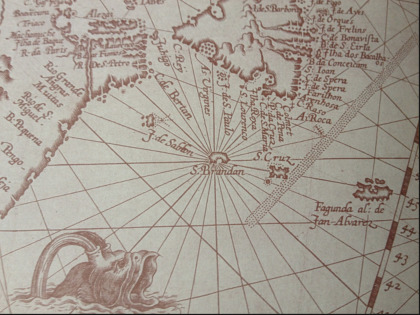
SAINT BRENDAN’S ISLE, HY-BRASIL, AND LOST ISLANDS
From the fall of Rome, Christian monks had fled persecution in Europe and Asia for Ireland. The Green Island was the refuge for scholars (and, some say, the remnants of the Knights Templars, who struck out from there and Scotland for the America continent in the late 14th century).
Medieval Ireland had a tradition of sea voyage tales called immrama that involved hidden magical and holy islands; Tir Na nOg, the Land of the Eternal Young, is probably the most famous version of this idea (although the actual entrances were through sacred burial mounds and caves either on or off islands). Inevitably the stories were Christianized, and by the 8th century someone had written The Voyage of Saint Brendan the Abbot. Many of its incidents were based on earlier immrama and probably Homer’s Odyssey. According to the text, sometime in the 6thcentury “Brendan the Navigator” and a dozen monks set out to find an island that a Saint Barrind had told him about. After a series of adventures involving (perhaps) icebergs, sea monsters, and angry Norse blacksmiths, they find this earthly paradise seven years later. Original locations for this isle (or archipelago) was the Madeira or Azores; by the 19th century it had “traveled” north, and could be seen/landed upon only by the worthy and those not seeking it.
A variation of this is Hy-Brasil, a mythical island off the western Irish coast, cloaked in mist, which was said to appear every seven years. It first appeared on a 1325CE portolan map. It continued to be represented on maps until the 18th century, and expeditions to find it were undertaken in the 15th century. Parallels with Avalon are inevitable.
THE ROSICRUCIANS
The two Rosicrucian manifestoes The Fame of the Brothers RC (1614) and the Confessions of the Brothers RC (1615) occupy a space between fact and fantasy. They became foundation myths for what would eventually become dozens of Rosicrucian Societies around the world. The Fame tells the story of a 14th century spiritual journeyman Christian Rosenkreuz’s travels to the East and his initiations into probably Sufi and Hermetic-Greek-Egyptian orders. A direct lineage of the teachings of German alchemist Heinrich Khunrath and British mage John Dee can be discerned in the Rosicrucian program. The tracts outline the eventual creation of a utopian society of Christian universalism (emphatically non-Catholic, however) dedicated to scientific melioration of humanity’s ills. This program would lead people to believe that Francis Bacon’s New Atlantis (1627) was a quasi-Rosicrucian work.
In 1666, Duchess Margaret Cavendish publishes The Blazing World, a novel about a utopian society on another planet accessible from a portal at the North Pole. Along with the Chemical Wedding and New Atlantis, Cavendish’s imaginative work signal the retreat of physical sanctuaries of peace into fictional and secret-societal hermetic ideals. Hence:
MODERNIST SUBSTITUTES
With growing industrialization and mass literacy came the escape into secular fictions that are more or less modeled upon these sacred journeys to hidden places. The near-completion of the global cartographic enterprise by the turn of the 20th century pushed back on the Imagination, which ever reaches beyond the line. Hence journeys to the inner earth, the moon, Mars, or submarine civilizations became popular.
John Cleves Symmes apparently began this “gold rush” to alternate worlds decades earlier with Circular Number 1 (1818), an attempt to convince the world’s governments and scientific societies to mount expeditions to the hollow earth through the poles. Inspired by astronomer Edmund Halley’s hypothesis, Symmes’s model for the inner earth was an inversion of the planetary spheres, a series of concentric rings through which one entered, mysteriously, through a gravitational vortex at the poles where an explorer’s forward motion equaled descent. Symmes’s entreaties came to naught, but someone—either Symmes himself or a Nathaniel Ames—wrote and published the novel Symzoniain 1820.
But even before this, Jack Casanova penned the nearly unread but bizarre 1,800 page Icosameron (1787), a story about sibling-lovers who spend 81 years living with a bizarre race in a mirror-earth within the planet. While technically a pre-Romantic work, it has all the signs of a counter-Enlightenment mentality.
Jules Verne’s A Journey to the Center of the Earth (1864) is the most famous adventure story of an arduous journey to an “unknown” place involving a secret itinerary (or clues to a passage to it). Theosophist/Rosicrucian Sir Edward “it was a dark and stormy night” Bulwer-Lytton wrote The Coming Race in 1871, the tale of a man’s accidental discovery of an advanced society of beings living within the earth. The next year Samuel Butler produced Erewhon: Or, Over the Range in 1872, an extended satirical description of an unknown surface country in which an artificial intelligence evolves from their own version of Blake’s “dark satanic mills,” the industrial factories. In Etidorhpa (1895), pharmacologist John Uri Lloyd did Bulwer-Lytton one better by creating a matrioshka-story structure in which a strange spiritual being named “I-Am-The-Man” is led into the hollow earth. There he learns alchemy and the spiritual nature of the universe, coming back to tell his story as a near-apparition to a Kentuckian journalist, whose manuscript the author, Lloyd, supposedly found.
Medium Helene Smith’s astral travels to the civilization of Mars were transcribed and interpreted by psychologist Theodore Flournoy in From India to the Planet Mars in 1900. Medium Sara Weiss added her own “scientifickal romance” Journeys to the Planet Mars, Or, Our Mission to Endo to the growing field of sci-fi in 1906. Willis Emerson’s The Smoky God (1908) added yet another fictional English/Scandinavian adventurer, Olaf Janssen, in traveling to the inner planes.
Each of these works describe utopian civilizations in sometimes excruciating detail (architecture, mores, laws, etc.), a tradition going back to Francis Bacon’s New Atlantis (1627), which you might say was a rough Elizabethan-era blueprint for the scientific technocracy that now exists all around us. But further devolvement of the secular geographical journey into sword-and-sorcery occurred with Edgar Rice Burroughs’s Pellucidar and John Carter of Mars series.
Of course, the most famous “hidden utopia” story is still Lost Horizon by James Hilton, which introduced mass Western audiences to Shangri-La, a beyul in the classic Hindu-Tibetan sense. Immortals, magic medicine, pacifism, all told in yet another double-frame story format.
With the further deenchantment of our physical neighborhood via astronomy, the imaginative mind inevitably turned to other worlds, to other times, to other dimensions—to the other in general, that is, anywhere but here and anywhen but now. This seems to be one of the main themes of Thomas Pynchon’s Against the Day (2006), which has numerous discussions of travel through the hollow earth, time travel, or to parallel versions of Earth, as well as a search for Shambhala and story arcs that use the Everett-Wheeler multiverse conjecture as a self-reflexive plot device. Pynchon’s first novel, V. (1963), mentions something called Vheissu (echoing a protagonist’s search for the V-named woman of the title) that is either a savage hidden land that refutes the foundations of all earthly politics, or a Borges-like infection of our world by an imaginary utopia.
WILD SCIENCE STEPS INTO THE BREACH: ONG’S HAT, THE GAME OF SUGGESTION, AND MIND-MAPS
The Pine Barrens of southern New Jersey has always had a reputation for supernatural goings-on. Just ask Paulie Walnuts and Chris Moltisanti.
Legend tripping came online in the early 1990s with the legend of the Moorish Ashram. Located in the Pine Barrens, the hamlet of Ong’s Hat (which doesn’t appear on 95% of New Jersey maps) was supposedly the site where a group of edge-thinkers, chaos magic devotees, and psychonauts developed a technology to travel to another, unspoiled version of earth via a vehicle called the Egg, then later by purely ritual means.
At first just a physical pamphlet, a list of suggested and necessary reading materials for ashram participants called the Incunabula Papers was posted online in connection with this gang of “rogue scientists.” The ideas of Henry Corbin figure in the legend via this catalogue, and one of the scientists named the alter-earth to which they retreated Hurqalya, after Suhrawardi’s transfigured imaginal earth-double. Incunabula mixed real books with invented ones, Borges-style, to weave in the older legends of the Philadelphia experiment of 1943 and its supposed successor, the Montauk project.
The legend all turned out to be the spawn of four primary individuals: Joseph Matheny, physicist Nick Herbert, poet Peter Lamborn Wilson (aka Hakim Bey), and Peter Moon. A small cadre of message board-lurkers picked up the “alternate reality game” and ran with it as factual, some going far as to visit the Ong’s Hat hamlet in search of either physical evidence or remnants of the portals. Matheny came fully clean after some hardcore fantasists refused to believe the group had made up the legend. The clues were there from the beginning (especially the references to the bogus Philadelphia experiment) but it all just ended up demonstrating the spiritual need people have for the utopian journey, as refracted through geography and high technology.
The extraordinary ABC series LOST capitalized on the concept of a Hy-Brasil-like “invisible” island in south Oceania that revitalized the trope of a hidden land, in which a pair of near-immortal brothers use it as a proving ground for human good and evil. Thanks to the depth of its characterizations and its carefully-unspooling plots-within-plots, LOST tries hard and mostly succeeds at using ancient tropes to recapture the wonder and purpose of the spiritual quest in a geographical context. The story is drawn bigger and bigger.
Bibliography
Bernbaum, Edwin. The Way to Shambhala: A Search for the Mythical Kingdom Beyond the Himalayas, Shambhala Publications, 2001.
Corbin, Henri. Creative Imagination in the Sufism of Ibn Arabi, Princeton University press, 1981.
-The Imaginal and the Imaginary
-Spiritual Body and Celestial Earth
Guenon, Rene. The King of the World, Sophia Perennis, 2004.
–Symbols of Sacred Science, Sophia Perennis,
Lebling, Robert, Legends of the Fire Spirits: Jinn and Genies from Arabia to Zanzibar, Counterpoint, 2011.
LePage, Victoria. Shambhala: The Fascinating Truth Behind the Myth of Shangri-La, Theosophical Publishing House, 1996.
Levenda, Peter. Stairway to Heaven: Chinese Alchemists, Jewish Kabbalists, and the Art of Spiritual Transformation, Continuum International Publishing Group, 2008.
Matheny, Joseph and Moon, Peter. Ong’s Hat: The Beginning.
Roerich, Nicolas. Shambhala: In Search of the New Era, Inner Traditions, 1990.
–Heart of Asia: A Memoir of the Himalayas, Inner Traditions, 1990.
Silverberg, Robert. The Realm of Prester Jean, Ohio University Press, 1996
——————-
[1] The hitherto hidden Qabbalistic forms of these rituals were “publicly” revealed with the discovery of a vast trove of medieval scriptures in the storeroom of the Ben Ezra synagogue in Cairo, 1753/1864/1896, and the Dead Sea Scrolls in 1947. These could both reasonably called instances of terma (treasure) discovery in the Tibetan tradition—that a cache of wisdom-filled documents are revealed at a certain time for people’s salvation—given the right amount of piety in absorbing and performing the rituals contained within.
[2] The washing of the mouth ceremony involved the introduction of magnetic ore into the water—lodestone ore from Magnesia ad Sipylum in Turkey.
[3] It is not noted in Muhammad’s mysterious account whether these djinn were immortal. Tradition says the “normal djinn” have very long lifespans and die, but the “exclusive” maleness of these first djinn in Qaf makes one wonder if the women perhaps were hidden away from his eyes, or that some means of technological reproduction was involved in their existence.
[4] The best dating to the letter was somewhere around 1165. Scholars Vasiliev and Silverberg and others had never really been able to determine who wrote it but its derogatory tone towards the Byzantine ruler Eugenus and the Greeks in general compelled them to conclude it was a Latin-speaking monk who lived in or was familiar with the Holy Lands and extant folklore or rumors about the East that made their way along the Silk Road—probably stories about the king blank in India conflated with stories about “exotic” Indian and Chinese technology. It’s possible the writer was even familiar with the Thousand Nights and a Night, whose stories feature fantastic lands and technologies like that of Prester Jean.
[5] This ritual is not to be taken lightly and requires months and months of preparation even to take on its preliminaries. It was the gift of the Buddha after parinirvana (bodily dissolution) when he assumed the form the Kalachakra deity, who taught the first Shambhalan king, Sucandra. Sucandra wrote extensive commentaries on it and created the first Kalacakra mandala, which has forever since been a very important public ritual, in a sand-based form, created by monks.
Notes on Entheogeographies of Salvation THE HEAVENLY LOCALES HIDDEN UPON AN ALTER-EARTH, OR ARE DISGUISED UPON THE PLANET All religions hold a variation of the belief in an earthly counterpart to paradise.
4 notes
·
View notes
Text
10 Places With The Strongest Energy Field
Many people who are either outdoor enthusiasts, or just generally spiritual people seek their spiritual experiences in nature. Across the world, there are various destinations that contain spiritual significance that is both sacred and spiritual places in nature. With thousands of years of spiritual history, these places can provide answers and enrichment on our paths to enlightenment, as well as provide concentrated energy that will bring you to new heights in your spiritual path.
These are the top 10 spiritual places found in the world that are worth visiting, regardless of your religion or spiritual views.
1. Machu Picchu, Peru

It has been said that the sacred city of the Incas is magical, and this is indeed very true. Built high in the Andes, this particular place is one of the “Seven Wonders of the World”, and boasts of amazing scenery and stone monoliths that will leave you in awe of its energetic qualities. It seems that this place itself channels massive amounts of energy and allows people to experience something that is out of this world.
2. Crater Lake, Oregon

Claimed to be a major intersection of the Earth’s global grid, it is said that healing clay can be found there. Not only that, but there are several powerful vortexes that are claimed to still exist around Crater Lake. This area was formed 8,000 years ago after a massage eruption led to Mount Mazama collapsing. Plunging nearly 2000 feet below ground, this lake is the deepest in the US and the seventh deepest in the world.
The Native American Klamath tribe has always found this lake to be a spiritual and sacred site. One legend says that the Chief of the Above World and the Chief of the Below World battled against one another, leading to the destruction of Mount Mazama. Long ago, tribesman would use Crater Lake for vision questing. This area is still considered a highly spiritual spot. As a part of Crater Lake National Park, as well as a part of spiritual history rich with potential for the experience of a lifetime, consider making this a list topper on your places to see list!
3. Easter Island, Chile

Easter Island, Chili is a highly isolated location and is not very well known to the general public. However, it is the home to some very massive statues, which interestingly enough cannot be linked to any particular creator. Scientists have absolutely no idea of how exactly they originated. The mysterious qualities of the island don’t stop there either. There are 53 stone houses which form an uninhabited village. There are no windows or doors in any of these homes. The big mystery concerning this island, though, is the “Navel of the World”. This is a circular stone that many believe holds the secrets of the universe as it supposedly collects most of the spiritual energy lines of our planet.
4. Mount Kailash, Tibet

Located in the North of the Himalayas, Tibet, this fascinating mountain is the spiritual center of four great eastern religions: Tibetan Buddism, Hinduism, Jainism and the ancient Tibetan religion that came before Buddhism-Bongo.
Many people have traveled from around the world to this mountain, and currently, a growing number of people believe that Mount Kailash is the energy center of the Earth. It is always a popular belief that the entrance to the Forbidden City-Shambhala- is located near the mountain. Going on a pilgrimage around Mount Kailash, and swimming in Lake Manasarovar, also located near Kailash, are considered spiritual experiences that encourage redemption while washing away the sins we have committed during our lifetime.
5. Rila, Bulgaria

People have referred to Rila Mountain as the Nose of the Earth, due to the fact that it stood above everything else without submerging into water. Although things have changed today, this mountain still stands close to the heavens and has managed to preserve some of the most impressive miracles found in this spiritual epicenter, namely the beautiful Seven Rila Lakes and the mesmerizing Stob pyramids.
The former boasts powers of spiritual cleansing by thousands of people each year, while the latter serves as natural anthology rich in ancient myths and legends.
6. Sedona, Arizona

Not only is Sedona beautiful and serene, it has long been considered a spiritual power center. The power and energy that emanates from the vortexes found in Sedona are unmatched. The energy that is found in Sedona is the main reason for the large New Age community that has begun to grow in the area. These communities, which hold a variety of spiritual beliefs, practices, and healing modalities are the reason Sedona is often referred to as a spiritual Disneyland.
Anyone who has a sensitivity to subtle energies would be overwhelmed with the experience of standing in one of these vortices, as the energy that flows through you can be intense. People from around the world come to Sedona to experience this.
7. Socotra Archipelago

Socotra is an archipelago of four islands in the Indian Ocean to the Horn of Africa. The largest island occupies about 95% of the total area. Many species that are found in this regions are specific to this region only, due to isolation. The majestic landscapes make this area appear to have come straight from a science fiction movie.
When you are in this area, the appearance and feel can make it seems as though you have slipped into another dimension. You can be connected directly to the cosmos through the energy channeled in this spiritual minefield.
8. Stonehenge, UK

Stonehenge lies silhouetted against the skyline and overlooking the windswept Salisbury Plain. In the past centuries, as well as today, many theories have been provided in an attempt to explain the existence of this stone temple. However, the reason remains a mystery.
Stonehenge is world famous for its spectacular solar alignment that can be seen at the summer solstice on June 21st. The midsummer sun is seen rising over the Heel Stone from the center, causing thousands of people to gather at the monument each year to experience this majestic sight. Ancient people found the cycles of the Sun and the Moon to be importance, and they revered these bodies as powerful deity that could impact their daily life. These people also found areas of the Earth as massive energy portals and vortexes and used them to build statues, monuments, and temples which helped them connect more powerfully to their own spirituality.
9. Bosnian Pyramids, Bosnia

Based on carbon analysis, it has been found that these pyramids have been around since before the Neolithic period. This would make them over 12,000 years old, or older than the Egyptian pyramids, which seem to be more commonly well-known. The lake which is found below it is beautiful, blue, and clear of any negative presence. This water is referred to as living water because it is said that it purifies the body. Rooms are also found below it which are underground, and known as the “healing rooms”. Many say that these rooms cause the human body to regenerate faster, causing quicker healing to take place in the body.
10. The Plateau Uluru, Australia

As Australia’s spiritual center, this place is located right in the middle of the continent. Many locals, as well as tourists, say that you can feel the energy emanating in the area quickly upon arrival. A hollow plateau faces you and is locally referred to as Tiukurpa, meaning Dreamtime. Spiritual visions can be common while you are in the Uluru Plateau.
Modern life can be very chaotic, and it becomes impossible to sit back and seek solace in the realms of our own mind and soul. These experiences not only center us while relieving stress, but also push us in a more spiritual direction where we can access inner peace, gratitude, forgiveness, and much more enlightenment. Visiting any of these places that are rich in spirituality and organic energetic fields is a great way to step back and find your own true spiritual awakening.
13 notes
·
View notes
Text
Amazing Tourist Attraction in Malvan - Best Places to Visit
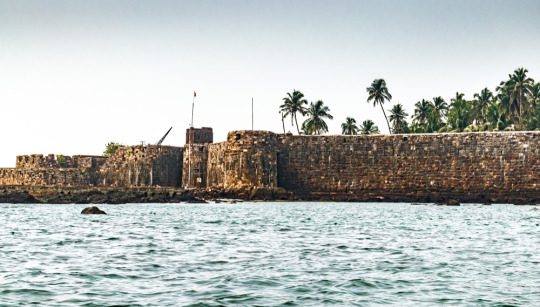
Malvan is a beautiful town located along the coast line of Sindhudurg district of Maharashtra. It is well known for its wide, clean, blue beaches and after sports activities being take place out on them. Experience the beauty of the ocean with this package of thrilling malvan water sports activities.
1. Sindhudurg Fort
Located off the coast of Maharashtra, the Sindhudurg Fort is an ancient fort occupying an island in the Arabian Sea. The Sindhudurg Fort is a concrete example of the Maratha foresight and resourcefulness. Not only is this mighty fort an important historically attraction, but the natural beauty of the surrounding countryside makes it a popular tourist destination. Construct by none other than Chhatrapati Shivaji, the construction of Sindhudurg Fort utilizes the natural reserves of the surrounding rocks to their advantage. With its solid ramparts and conspicuous gateways, this fort is a fascinating piece of history which makes it a popular tourist spot.
2. Tsunami island
Tsunami Island is the adventure center in Malvan - a paradise for adventure seekers and water lovers. It is famous for various water sports such as jet skiing, banana boats, kayaking and bumper boats. The sand found on the malvan island goa is said to be magnetic and possesses the ability to cure joint ailments when massaged on the affected areas of the body. There are several huts and shacks alongside the beach where you can get some good beer and snacks to have a good time. This is one of the most popular tourist place in Tarkarli, as various adventure sports like scuba diving, paragliding, parasailing, banana boats and bumper riding among other such fun activities can be available here. The island resembles similarities with the atmosphere of Goa.
3. Rock Garden
Rock garden is a well-maintained and naturally designed garden, an attraction of Malvan. The rocks are really huge with the waves hit on them with full vigour. If you visit Malvan, a visit to the rock garden don't be missed. The crabs running around on the rocks give a wonderful insight of the rich marine life. Garden is quite attractive with greenery and flowers all around. The Best part is you can walks towards sea from garden. It’s an ideal place to just sit and watch the sunset. Perfect for budding photographers.
4. Chivala Beach
With an endless vacation for fun and adventure, one can have a great a time by tripping to Goa. Perfect day outcomes with a combination of endless explorations. Chivala beach is one of the famous destinations in Goa for water adventures. lodging house to frightening feats, Malvan Beach is a beautiful dive goa spot. The underwater spectacular beauty is an absolute marvel to explore. Tourists can enjoy their adrenaline rush by participating in adventure activities such as snorkeling, skiing and swimming, malvan scuba diving goa.
5. Rameshwar Temple
Considered as one of the 12 Jyotirlingas, it is one of the most beautiful shrines of Lord Shiva. Boasting of long corridors, carved pillars, artwork and figurines, the temple comprises of two shiva lingas. The temple comprises of the longest cloister in comparison to other Hindus temples in the country. The exterior of the shrine is decorated with intricate carvings which, in turn. enhances its beauty. One of the Shivalingas was made by Goddess Sita and the other was brought from Mount Kailash by Lord Hanuman.
6. Takarli Beach
This is one of the famous places to visit in Malvan, located at the confluence of the Arabian Sea and the Karli River, overlooking Tarkarli river and estuary. Tarkarli beach is the only snorkeling and diving training center in Maharashtra, and its famous for diving, water scooter rides, snorkeling, houseboat stays and paragliding in goa beach.
0 notes
Text
Travels by David Kaplan
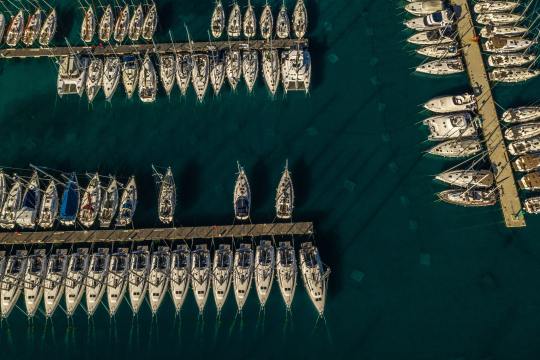
Opening new horizons is a way of life for millions of people who do not wait for free time, do not take a rain check indefinitely, but simply plan and go. Traveling is an investment that makes a person happier and more prosperous.
David Kaplan knows how to travel with pleasure. The list of his trips is rich: he explored almost all the world's cities, having visited 65 countries. He knows where it is best in the fall, winter, spring, or summer. Where to go with a big company, and where it is better to relax on your own. He knows what cities are a must in your bucket list, what cities deserve only 1-day stop, and where you should not go. In each beloved town, he has at least five favorite restaurants.
The world is the home of cosmopolitan.
For many, the homeland is the place where they were born, went to school, were free and happy. David Kaplan was born in 1963 in European Jerusalem - the Lithuanian city of Vilnius - in a traditional Jewish family with fidelity to the Jewish spiritual traditions and values . The Kaplan family lived for many years in Lithuania. After graduating from the Faculty of Applied Mathematics of Vilnius State University, David remained in Vilnius for some time, later he moved to his historical homeland Israel. He worked in Russia for many years. He is a true citizen of the world. But no matter how much a person travels, he can be happy and free only at home, surrounded by his people. For David Kaplan, the homeland is Israel. Today he lives and works in Jerusalem. The travel experience of this cosmopolitan of Jewish origin can be trusted. Travel around the world with David Kaplan!
✓ David Kaplan recommends planning all your trips.
You prepare everything in a pleasant expectation, then you enjoy it, and after all, you have something to remember. I advise you always to prepare for the trip. When traveling, the place where you can have some rest is essential. Also, it's crucial to find right people to travel with. Think about who you want to spend time with and where. Then make a list of places where to go and with whom you want to go. And after that, be sure to coordinate your plan with friends and relatives. Also, the rest must somehow be interfaced with business or with a hobby. The more hobbies a person has, the more reasons he has to travel.
✓ David Kaplan recommends traveling with a company.
My advice is to travel as often as possible with a large, friendly and fun company minimum of 4-6 people: family, friends, acquaintances, etc. But some places are definitely created for privacy. There, a person gets charged with a unique energy. Such secluded trips most often occur in the fall. Not late nostalgic, but early autumn, filling spiritually.
✓ David Kaplan offers criteria for choosing a place of travel.
In choosing a city for travel, there is no concept of winter or summer. David Kaplan recommends going where you have not been. Age also matters: at different ages, you can see London and New York in different ways, as well as museums and attractions. It is important to consider financial capabilities. No one will go to the most expensive city in the world if he has a limited budget. Thus, the choice is divided into two groups: according to interests and opportunities. At the same time, there are places that, on the recommendation of David Kaplan, should be visited by every self-respecting person. Cities: Baden-Baden, Vancouver, San Francisco, New York, London, Paris, Rome. Islands: Bermuda, Caribbean, Maldives, Seychelles. You can go to Belgium only for the best food. If you would like to travel with children, Turkey would be an option!
✓ David Kaplan advises returning to where it felt good.
The desire to return to a particular city is not related to geographical location. Someone returns to their favorite museum or an annual event, someone to their favorite restaurant or a club. I want to go back to where there is something specific that you enjoyed. You come back for impressions to once again catch these emotions.
The second factor that brings people back to the city is owning real estate there. The third factor is the residence of relatives or friends. Therefore, each has its personal "return."
✓ David Kaplan teaches you how to travel through photographs.
I believe that there is nothing to go to New Zealand and Egypt. You do not graze goats, but you can see the pyramids by photos or films. Here is my recommendation for choosing a place to travel: to buy BBC and Discovery documentaries. If you see something that touches you, you should fly there.
✓ David Kaplan recommends going on a trip at least once
A single trip is enough for all of Southeast Asia. If we talk about a tourist trip to Japan, I advise you to opt for the city of Kyoto, especially in spring, during the cherry blossoms season. At the same time, stay there for at least two weeks to fully feel the place. Visually, this is an entirely different world. You must carefully prepare for such ambiguous trips: sit down with books, read everything in detail, discover the history - then this great country will open its doors for you. Without preparation, the trip will be nothing but a waste of time. Once you can go to Morocco, the island of Fiji and the city of Cancun with its sea, stars, and discos.
✓ David Kaplan recommends traveling all year round.
In fall. When summer has already ended, but autumn has not yet arrived, when it is still not cold, but not hot, I recommend going to Lake Como in Italy, to Baikal or Altai in Russia. These are some of my favorite places. When summer goes turns into autumn, these places are utterly enchanting. Pastel colors, peaceful calm atmosphere – you can sit in silence and look at the water. Altai is a place of extraordinary power. Having traveled to 65 countries, it was in Altai that I saw nature from all countries accumulated in one region. That beauty is unreal.
In fall, David Kaplan recommends a six-hour road trip from Montreal to New York. Fantastic views await you along the way. You pass Niagara Falls, then you see a maple forest, beautiful, green, yellow, white, blue mountains, rocks. You can go crazy with pleasure. Nature lovers must visit the magical Waterloo Forest in Belgium.
In winter. I recommend Courchevel. A paradise for those who love skiing. In terms of service, there are many better places. But it is in Courchevel where the best ski logistics in the world is, and this is the best place for the beginners.
In spring. The annual spectacular sight in late March-early April is the cherry blossoms. First, go to Tokyo, and in 5-7 days, I advise you to get to Kyoto. Also, in spring, it's an option to spend some time on the tropical island of St. Barth. It is called the island of millionaires. There are the best villas, hotels, and yachts in the Caribbean. I also recommend St. Thomas with its unique island exotic framed by dense tropical greenery and stunning bays with snow-white sand.
The summertime destination should be Italy. Especially Sicily with its many islands: Panarea, Taormina. I recommend going on a date with active volcanoes on the islands of Stromboli and Vulcano. I also advise you to visit the Greek paradise: the snow-white romantic island of Santorini and one of the most mysterious legendary places - Mount Athos.
In June-July it is good to travel to Asia. David Kaplan recommends visiting the abode of the world - the fabulous country of Brunei. It's known to be one of the wealthiest countries in the world. You'll find luxurious palaces and mosques, mountains, rainforests, waterfalls, white beaches, and the gentle sea there. Devote one of the summer vacations to the mysterious Buddhist kingdom of Tibet: lakes, majestic Kailash, distinctive culture, and religion. After Tibet, you start looking at the world differently. It is unforgivable to be in China and not visit the legendary Shaolin Monastery in the Songshan Mountains.
There are a lot of options for summer travel. Behind the atmosphere of quiet luxury, David Kaplan advises you to go to Tahiti or Bora Bora with their picturesque bays and the best snorkeling in the world.
In August, visit the most beloved Scottish Queen Mary Stuart. The famous castle and the picturesque lake with the same name of Linlithgow. In this country, you can master archery and try yourself in the ancient and aristocratic sport - falconry with Harris hawks. A unique activity for me is golf. Scotland is the birthplace of it. There are more than 500 golf courses throughout the country, some of which are among the best in the world. Golf is enchanting.
From August to the end of September, David Kaplan recommends going to Norway for fantastic sunsets and real performance of dancing lights turning into the northern lights. Another main attraction of this country is the stunning beauty of the fjords.
The North Pole is a pearl of your summer vacation. The Arctic summer does not last long, only two to three weeks. As a rule, a trip to the realm of ice and snow can only be carried out on an icebreaker, and you can only fly to some rocky shores by helicopter. Such a trip is incomparable. The North Pole is the top of the world. Only there you can take a breeze of fresh polar air, see drifting perennial ice floes, arctic flowers, and the rarest polar animals such as whales, belugas, seals and, of course, polar bears.
After such a trip, you will undoubtedly want to go to the South Pole in December and January and make a circle around the globe. Visit Antarctica and see with your own eyes a colony of emperor penguins.
I wish you unforgettable travels!
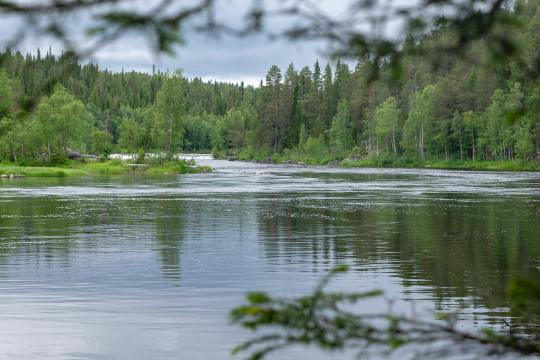
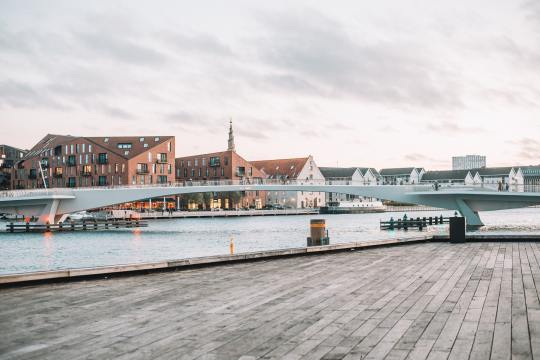
1 note
·
View note
Text
How To Life Chapter 39 - Hinduism
How About An Old Faith That Isn’t Dead?
I want to be very clear that I have exceedingly little personal experience with Hinduism (outside of maybe the occasional slightly racist depiction in old cartoons). Why bother trying to explain these things if I’m not personally affiliated with them, you might ask? Several reasons: 1. Mythologies and religions are really fascinating to me, 2. Even if my knowledge is limited, I want to offer as many religious options as possible for you readers to examine in order to learn about yourselves, and 3. Because I find it hilarious when an ignorant white kid desperately tries to understand several-thousand year old cultural ideas, religion, and history to then abridge it and laugh awkwardly when he has no idea what the hell’s going on.
Hinduism is considered one of (if not THE) oldest living religion on Earth. As in, it’s something that people still actively practice and believe in. I really joke at the expense of Egyptian mythology, but that’s way easier to do when everyone who practiced it is long dead. I know that I clearly love taking cheap-shots at ideas and faiths that I clearly don’t understand, but I will admit that I do have respect for the culture and history behind these faiths (regardless of whether or not I have any actual belief in the spiritual stuff). If I were actually to go into tons of detail about all of this stuff, I can’t even imagine how long this damn book would be. The stuff behind these faiths in just plain interesting, and were I someone who actually has any business talking about it, I’d LOVE to give a more serious understanding to you all.
However, this book exists largely for the sake of comedy and vague guidance. I have enough respect for you to know that you can tell this isn’t a completely accurate telling of this faith.
In terms of actual details of the faith, it’s a massive collection of various Indian cultures, ideals, practices, rituals, cosmology, and various other buzzwords for a proper religion. Think of it as a sandwich of Hindu culture, made up of bits and pieces of countless ingredients. You probably would have quite a hard time eating this metaphorical sandwich.
Name just about any aspect of life, and there’s some part of Hinduism that could help guide you along. Whether it’s what duties you should complete, how to balance out your very existence, how reincarnation works, or just interesting ways to have sex, there’s some part of Hindu faith for it. Hardly surprisingly that people are still taking bites out of this ever-lasting metaphorical sandwich.
The meal won’t be complete, however, without learning about the gods and the crazy shit they get up to. Now, being that Hinduism is such a massive collection of various ideas brought together, there are tons of different interpretations of the stuff in their cosmology based off of what sects any person might be a part of. Basically, get ready for branching paths.
The beginning of the universe came about through: A. A giant golden egg. B. The limbs of some dude who was sacrificed to the gods. C. Vishnu (one of the most important Hindu deities) diving into the waters of the cosmos and finding Earth at the bottom (probably next to a band-aid).
Another option is that Brahma (another super important Hindu deity) was sitting around alone in the universe. He decided to make a husband and wife for the sake of company (because I guess he likes being a third wheel). Wife fucked off, however, and Husband chased after her. Wife cleverly changed into various animals who are then had sex with by Husband (thankfully also as that animal) which resulted in many species coming into existence.
Regardless of which path you take, Brahma is generally considered the “Uber-God” for most types of Hinduism. He’s got four heads and is responsible for four of the most important Hindu texts (the Vedas). Fun fact; his main mode of transport is a swan.
The second of the major god trio is Vishnu. He has four arms, each holding a different important object/metaphor. He works as the protector to Brahma’s creation. Fun fact about Vishnu; he’s got blue skin. No word on whether or not he receives any worship from the Smurfs.
Filling out the main Hindu gods trio is Shiva, the destroyer. Depending on what version you follow, his personality is a tiny bit different. Some see him as being super chill, living on Mount Kailash and spending time with his wife and kids. Others see him as being totally OP, choosing to spend his time killing the shit out of demons. Either way, he still finds time for yoga and art.
In reality, there are more gods, demi-gods, local gods, and reasonably important spiritual beings than you can shake a non-metaphorical sandwich at, but those three are the most major ones. Most also have a bunch of different forms that they go through. It’s ALOT to keep track of and most different sects of Hinduism don’t even agree on who’s the most powerful or who even does what when sometimes.
The last aspect of Hinduism that I’ll briefly mention is the afterlife. Unlike most western faiths that focus on a single afterlife, Hinduism involves lots of reincarnation and rebirth. Mainly that you get to spend time in a “good” world for being a swell fella or a “bad” one for being a not so swell fella (and eventually making trips back to Earth). After enough run-throughs of these good, bad, and Earthy lives, you’ll hopefully eventually reach the ultimate understanding of the universe and get to spend the rest of eternity with the supreme god. Basically, you’ve really gotta work for salvation when it comes to Hinduism.
GOOD IDEAS:
- One of the oldest faiths, so it comes with tons of material.
- Covers just about every single detail of life you could want.
BAD IDEAS:
- Finer details are harder to pin down as you cross the boundaries of different sects.
- Too many afterlives IMO. I think I get the point after like the 4th one.
LIKELIHOOD OF TRUTH: ~60%. Being arguably the oldest living faith on Earth gets you some points, but the amount of divisions that have happened over time also hurt it a bit when it comes to figuring what is true. A good choice if you enjoy history and a challenge, however.
(Previous Chapter) | (Archive) | (Next Chapter)
1 note
·
View note
Text
The Satluj River
13-10-08 217 CONFLUENCE OF INDUS RIVER N (Photo credit: Wikipedia)
The Satluj River (Urdu: درياۓ ستلُج), (alternatively spelled as Sutlej River) (Bengali: শতদ্রু,Punjabi: ਸਤਲੁਜ, and Hindi: सतलज) is the longest of the five rivers that flow through the historic crossroad region of Punjab in northern India and Pakistan. It is located north of the Vindhya Range, south of the Hindu Kush segment of the Himalayas, and east of the Central Sulaiman Range in Pakistan.
The Sutlej is sometimes known as the Red River. It is the easternmost tributary of the Indus River. Its source is from Lowangko Co, Tibet near Lake Rakshastal in Tibet, China, near Mount Kailas, and it flows generally west and southwest entering India through the Shipki La pass in Himachal Pradesh. In Pakistan, it waters the ancient and historical former Bahawalpur state. The region to its south and east is arid, and is known as Cholistan a part of Bahawalpur Division. The Sutlej is joined by the Beas River in Hari-Ke-Patan, Amritsar, Punjāb, India, and continues southwest into Pakistan to unite with the Chenab River, forming the Panjnad River near Bahawalpur. The Panjnad joins the Indus River at Mithankot. Indus then flows through a gorge near Sukkur, flows through the fertile plains region of Sindh, forming a large delta region between the border of Gujarat, India and Pakistan, and finally terminates in the Arabian Sea near the port city of Karachi in Pakistan.
Contrary to the claims of Punjab state in India, a small part of Haryana state in Panchkula district is part of the Sutlej river basin area in addition to Punjab and Himachal Pradesh in India.[1] Thus, Haryana is also a riparian portion of the Indus river basin.
The waters of the Sutlej are allocated to India under the Indus Waters Treaty between India and Pakistan, and are mostly diverted to irrigation canals in India.[2][dead link] There are several major hydroelectric projects on the Sutlej, for example, the 1,000 MW Bhakra Dam, the 1,000 MW Karcham-Wangtoo and the 1,530 MW Nathpa Jhakri Hydroelectric Dam.[3] There has been a proposal to build a 214-kilometre (133 mi) long heavy freight canal, known as the Sutlej-Yamuna Link (SYL),[4] in India to connect the Sutlej and Yamuna rivers. This canal is designed to connect the entire Ganges, which flows to the east coast of the subcontinent, with points west (via Pakistan). When completed, the SYL will allow shipping from India's east coast to the west coast and the Arabian sea, drastically shortening shipping distances and creating important commercial links for north-central India's large population. However, the proposal has met with obstacles and has been referred to the Supreme Court.
History
The Upper Sutlej Valley was once known as the Garuda Valley by the Zhang Zhung, the ancient civilization of western Tibet. The Garuda Valley was the centre of their empire which stretched many miles into the nearby Himalayas. The Zhang Zhung built a towering palace in the Upper Sutlej Valley called Kyunglung, the ruins of which still exist today nearby to the village of Moincer, southwest of Mount Kailash (Mount Ti-se) Eventually the Zhang Zhung were conquered by the Tibetan Empire.
Today, the Sutlej Valley is inhabited by nomadic descendants of the Zhang Zhung who live in tiny villages of as yak herders.
Geology
See also: Ghaggar-Hakra River
The Sutlej, along with all of the Punjab rivers, is thought to have drained east into the Ganges prior to 5 mya.[5]
There is substantial geologic evidence to indicate that prior to 1700 BC at the latest, Sutlej was an important tributary of the Ghaggar-Hakra River (possibly through the Saraswati river) rather than the Indus with various authors putting the redirection from 2500-2000 BC.[6][7] or 5000-3000 BC[8] Geologists believe that tectonic activity created elevation changes which redirected the flow of Sutlej from the southeast to the southwest.[citation needed] The mighty Saraswati then began to dry up, causing desertification of Cholistan and the eastern part of the modern state of Sindh. The desertification resulted in abandonment of numerous ancient human settlements along the banks of Saraswati.[citation needed]
There is some evidence that the high rate of erosion caused by the modern Sutlej River has influenced the local faulting and rapidly exhumed rocks above Rampur.[9] This would be similar to, but on a much smaller scale than, the exhumation of rocks by the Indus River in Nanga Parbat, Pakistan. The Sutlej river also exposes a doubled inverted metamorphic gradient.[10]
The source of the Sutlej is just west of Mt. Kailash in western Tibet. This is a roadless area, and was first explored by kayak and raft by Russian and German teams in 2004.[11]
The largest modern industrial city along the Sutlej river banks is Ludhiana.
0 notes
Text
High Camp Adventure website Links
https://www.highcampadventure.com/
https://www.highcampadventure.com/bhutan-tours/
https://www.highcampadventure.com/all-best-selling-tours/
https://www.highcampadventure.com/currency-credit-cards-and-foreign-payment/
https://www.highcampadventure.com/bungee-jumping-in-nepal/
https://www.highcampadventure.com/peak-climbing-in-nepal/
https://www.highcampadventure.com/jungle-safari-in-nepal/
https://www.highcampadventure.com/cultural-tours-in-nepal/
https://www.highcampadventure.com/people-and-language-of-nepal/
https://www.highcampadventure.com/terms-and-conditions/
https://www.highcampadventure.com/why-travel-with-high-camp-adventure/
https://www.highcampadventure.com/history-of-nepal/
https://www.highcampadventure.com/contact-us/
https://www.highcampadventure.com/privacy-and-policy/
https://www.highcampadventure.com/message-from-managing-director/
https://www.highcampadventure.com/sitemap/
https://www.highcampadventure.com/trekking-in-nepal/
https://www.highcampadventure.com/tibet-tours/
https://www.highcampadventure.com/photo-gallery/
https://www.highcampadventure.com/videos/
https://www.highcampadventure.com/best-time-to-travel-nepal/
https://www.highcampadventure.com/expedition-in-nepal/
https://www.highcampadventure.com/tibet/
https://www.highcampadventure.com/expedition-in-nepal
https://www.highcampadventure.com/annapurna-base-camp-trekking/
https://www.highcampadventure.com/our-team/
https://www.highcampadventure.com/social-responsibility/
https://www.highcampadventure.com/langtang-valley-trekking/
https://www.highcampadventure.com/nepal/
https://www.highcampadventure.com/about-us/
https://www.highcampadventure.com/festivals-in-nepal/
https://www.highcampadventure.com/culture-and-religion-in-nepal/
https://www.highcampadventure.com/cultural-tours-in-nepal
https://www.highcampadventure.com/everest-base-camp-trekking/
https://www.highcampadventure.com/travel-guides/
https://www.highcampadventure.com/getting-in-nepal/
https://www.highcampadventure.com/rafting-in-nepal/
https://www.highcampadventure.com/geography-of-nepal/
https://www.highcampadventure.com/destinations/
https://www.highcampadventure.com/legal-documents/
https://www.highcampadventure.com/peak-climbing-in-nepal
https://www.highcampadventure.com/trekking-in-nepal
https://www.highcampadventure.com/mountain-flight/
https://www.highcampadventure.com/communication-in-nepal/
https://www.highcampadventure.com/alert-with-illegal-operators/
https://www.highcampadventure.com/accommodation-in-nepal/
https://www.highcampadventure.com/write-a-review/
https://www.highcampadventure.com/day-tours/
https://www.highcampadventure.com/read-reviews/
https://www.highcampadventure.com/jungle-safari-in-nepal
https://www.highcampadventure.com/rafting-in-nepal
https://www.highcampadventure.com/company-profile/
https://www.highcampadventure.com/manaslu-circuit-trekking/
https://www.highcampadventure.com/annapurna-circuit-trekking/
https://www.highcampadventure.com/faqs/
https://www.highcampadventure.com/bhutan/
https://www.highcampadventure.com/fixed-departure-date/
https://www.highcampadventure.com/nepal-visa-information/
https://www.highcampadventure.com/blog/
https://www.highcampadventure.com/blog/why-trekking-in-everest-region/
https://www.highcampadventure.com/best-selling-packages/
https://www.highcampadventure.com/blog/everest-base-camp-trek-packing-list/
https://www.highcampadventure.com/lhasa-tibet-short-tour/
https://www.highcampadventure.com/peak-climbing-in-nepal/contact-us/
https://www.highcampadventure.com/ruby-valley-trek/
https://www.highcampadventure.com/langtang-trekking/
https://www.highcampadventure.com/dolpo-trekking/
https://www.highcampadventure.com/pokhara-valley-tour/
https://www.highcampadventure.com/expedition-in-nepal/contact-us/
https://www.highcampadventure.com/pisang-peak-climbing/
https://www.highcampadventure.com/annapurna-circuit-with-mesokanto-pass-trek/
https://www.highcampadventure.com/naya-kanga-peak-climbing/
https://www.highcampadventure.com/rupina-la-pass/
https://www.highcampadventure.com/ganesh-himal-trekking/
https://www.highcampadventure.com/tibet-tours/contact-us/
https://www.highcampadventure.com/jungle-safari-in-nepal/contact-us/
https://www.highcampadventure.com/everest-panorama-trek/
https://www.highcampadventure.com/cho-oyu-expedition/
https://www.highcampadventure.com/gokyo-lake-trekking/
https://www.highcampadventure.com/bungee-jumping-in-nepal/contact-us/
https://www.highcampadventure.com/jomsom-muktinath-trekking/
https://www.highcampadventure.com/mera-peak-climbing/
https://www.highcampadventure.com/mohare-danda-trek/
https://www.highcampadventure.com/sunkoshi-river-rafting/
https://www.highcampadventure.com/everest-advanced-base-camp-trekking/
https://www.highcampadventure.com/blog/everest-base-camp-trek-difficulty/
https://www.highcampadventure.com/our-team/team/1/ishwar-pyakurel
https://www.highcampadventure.com/blog/best-time-for-trekking-to-everest-base-camp/
https://www.highcampadventure.com/kathmandu-valley-tour/
https://www.highcampadventure.com/khopra-ridge-khayar-lake-trekking/
https://www.highcampadventure.com/bhutan-tours/contact-us/
https://www.highcampadventure.com/all-best-selling-tours/everest-base-camp-trekking/
https://www.highcampadventure.com/everest-trekking/
https://www.highcampadventure.com/rafting-in-nepal/contact-us/
https://www.highcampadventure.com/off-the-beaten-path-trekking/
https://www.highcampadventure.com/dhampus-sarangkot-trek/
https://www.highcampadventure.com/day-tours/contact-us/
https://www.highcampadventure.com/annapurna-trekking/
https://www.highcampadventure.com/lumbini-pilgrimage-tour/
https://www.highcampadventure.com/world-heritage-tour/
https://www.highcampadventure.com/everest-expedition-south-col/
https://www.highcampadventure.com/chulu-east-peak-climbing/
https://www.highcampadventure.com/helicopter-tour/
https://www.highcampadventure.com/mustang-trekking/
https://www.highcampadventure.com/ghalegaun-trek/
https://www.highcampadventure.com/mardi-himal-trek/
https://www.highcampadventure.com/blog/everest-base-camp-trek-in-april/
https://www.highcampadventure.com/arun-valley-trekking/
https://www.highcampadventure.com/manaslu-trekking/
https://www.highcampadventure.com/ghorepani-poon-hill-trek/
https://www.highcampadventure.com/short-trekking/
https://www.highcampadventure.com/karnali-river-rafting/
https://www.highcampadventure.com/royal-trek/
https://www.highcampadventure.com/manaslu-and-tsum-valley-trekking/
https://www.highcampadventure.com/bhotekoshi-river-rafting/
https://www.highcampadventure.com/ama-dablam-expedition/
https://www.highcampadventure.com/blog/category/tours/
https://www.highcampadventure.com/tent-peak-tharpu-chuli-climbing/
https://www.highcampadventure.com/all-best-selling-tours/manaslu-circuit-trekking/
https://www.highcampadventure.com/cultural-tours-in-nepal/contact-us/
https://www.highcampadventure.com/blog/category/everest-region-guide/
https://www.highcampadventure.com/everest-base-camp-with-gokyo-valley-trekking/
https://www.highcampadventure.com/baruntse-expedition/
https://www.highcampadventure.com/pumo-ri-expedition/
https://www.highcampadventure.com/lhotse-expedition/
https://www.highcampadventure.com/kanchenjunga-expedition/
https://www.highcampadventure.com/chulu-west-peak-climbing/
https://www.highcampadventure.com/upper-mustang-trekking/
https://www.highcampadventure.com/everest-high-passes-trekking/
https://www.highcampadventure.com/makalu-expedition/
https://www.highcampadventure.com/dhaulagiri-circuit-trek-19-days/
https://www.highcampadventure.com/restricted-area-trekking/
https://www.highcampadventure.com/blog/category/trekking/
https://www.highcampadventure.com/jiri-to-everest-base-camp-trek/
https://www.highcampadventure.com/yala-peak-climbing/
https://www.highcampadventure.com/muktinath-tour/
https://www.highcampadventure.com/chitwan-jungle-safari/
https://www.highcampadventure.com/humla-simikot-mount-kailash-tour/
https://www.highcampadventure.com/langtang-circuit-trekking/
https://www.highcampadventure.com/glimpse-of-bhutan-tour/
https://www.highcampadventure.com/upper-mustang-saribung-peak-climbing/
https://www.highcampadventure.com/nepal-holiday-tour/
https://www.highcampadventure.com/lobuche-peak-climbing/
https://www.highcampadventure.com/mountain-flight/contact-us/
https://www.highcampadventure.com/ganesh-himal-region-trekking/
https://www.highcampadventure.com/heli-tour/
https://www.highcampadventure.com/bungee-jumping/
https://www.highcampadventure.com/blog/category/langtang-region-guide/
https://www.highcampadventure.com/pikey-peak-trek/
https://www.highcampadventure.com/langtang-valley-ganja-la-pass-trek/
https://www.highcampadventure.com/nepal-tibet-cultural-tour/
https://www.highcampadventure.com/all-best-selling-tours/annapurna-circuit-trekking/
https://www.highcampadventure.com/all-best-selling-tours/langtang-valley-trekking/
https://www.highcampadventure.com/bardia-jungle-safari/
https://www.highcampadventure.com/tsum-valley-trek/
https://www.highcampadventure.com/blog/everest-base-camp-trek-weather/
https://www.highcampadventure.com/hiunchuli-peak-climbing/
https://www.highcampadventure.com/mount-kailash-mansarovar-tour/
https://www.highcampadventure.com/blog/category/annapurna-region-guide/
https://www.highcampadventure.com/kanchenjunga-trekking/
https://www.highcampadventure.com/nar-phu-valley-trekking/
https://www.highcampadventure.com/kali-gandaki-river-rafting/
https://www.highcampadventure.com/dhaulagiri-expedition/
https://www.highcampadventure.com/helambu-trekking/
https://www.highcampadventure.com/makalu-trekking/
https://www.highcampadventure.com/tamang-heritage-trail-trek/
https://www.highcampadventure.com/other-trekking/
https://www.highcampadventure.com/honeymoon-tour/
https://www.highcampadventure.com/annapurna-panorama-trek/
https://www.highcampadventure.com/seti-river-rafting/
https://www.highcampadventure.com/all-best-selling-tours/annapurna-base-camp-trekking/
https://www.highcampadventure.com/trishuli-river-rafting/
https://www.highcampadventure.com/kathmandu-lhasa-overland-tour/
https://www.highcampadventure.com/tibet-everest-base-camp-tour/
https://www.highcampadventure.com/blog/category/manaslu-trek-guide/
https://www.highcampadventure.com/tamur-river-rafting/
https://www.highcampadventure.com/tamang-heritage-langtang-valley-trek/
https://www.highcampadventure.com/island-peak-imja-tse-climbing/
https://www.highcampadventure.com/cho-oyu-expedition/contact-us/
https://www.highcampadventure.com/annapurna-circuit-with-mesokanto-pass-trek/contact-us/
https://www.highcampadventure.com/blog/everest-base-camp-trek-in-february/
https://www.highcampadventure.com/numbur-cheese-circuit-trekking/
https://www.highcampadventure.com/khopra-ridge-khayar-lake-trekking/contact-us/
https://www.highcampadventure.com/lhasa-tibet-short-tour/contact-us/
https://www.highcampadventure.com/sunkoshi-river-rafting/contact-us/
https://www.highcampadventure.com/our-team/team/1/ishwar-pyakurel/
https://www.highcampadventure.com/pokhara-valley-tour/contact-us/
https://www.highcampadventure.com/blog/everest-base-camp-and-altitude-sickness/
https://www.highcampadventure.com/blog/complete-guide-to-everest-base-camp/
https://www.highcampadventure.com/pisang-peak-climbing/contact-us/
https://www.highcampadventure.com/guerrilla-trek/
https://www.highcampadventure.com/rara-lake-trekking/
https://www.highcampadventure.com/rupina-la-pass/contact-us/
https://www.highcampadventure.com/dolpo-trekking/contact-us/
https://www.highcampadventure.com/langtang-trekking/contact-us/
https://www.highcampadventure.com/bhairav-kunda-trekking-12-days/
https://www.highcampadventure.com/panch-pokhari-trekking/
https://www.highcampadventure.com/ganesh-himal-trekking/contact-us/
https://www.highcampadventure.com/mera-peak-climbing/contact-us/
https://www.highcampadventure.com/naya-kanga-peak-climbing/contact-us/
https://www.highcampadventure.com/everest-trekking/contact-us/
https://www.highcampadventure.com/kanchenjunga-trek/
https://www.highcampadventure.com/jomsom-muktinath-trekking/contact-us/
https://www.highcampadventure.com/kathmandu-valley-tour/contact-us/
https://www.highcampadventure.com/ruby-valley-trek/contact-us/
https://www.highcampadventure.com/blog/how-to-prepare-for-the-everest-base-camp-trek/
https://www.highcampadventure.com/blog/everest-base-camp-trek-in-march/
https://www.highcampadventure.com/everest-advanced-base-camp-trekking/contact-us/
https://www.highcampadventure.com/pikey-peak-and-dudh-kunda-trek/
https://www.highcampadventure.com/khaptad-trek/
https://www.highcampadventure.com/upper-dolpo-trekking/
https://www.highcampadventure.com/lower-dolpo-trekking/
https://www.highcampadventure.com/indigenous-peoples-trail-trekking/
https://www.highcampadventure.com/makalu-base-camp-trekking/
0 notes
Text
Theory on the guardian Temple: Mount Kailash
Every since "The Collector" I was convinced that the guardian mountain in Miraculous is most likely inspired by a real life counterpart. Then "Feast" came around and confirmed it to me. So I started to do some research and here we are with my answer and a new theory: Mount Kailash.
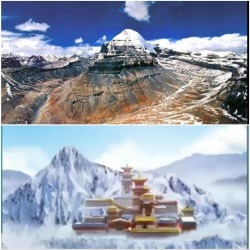
This mountain is surrounded by mysteries GALORE and its was such an interesting research to do! The more I read up on it the more I was convinced that this is indeed the inspiration of the guardian mountain in Tibet (and its entire society) we see in the show.
So let's not waste any more time and let's dive in. As always, I have alot to say ^^
As always, starting with the basics:
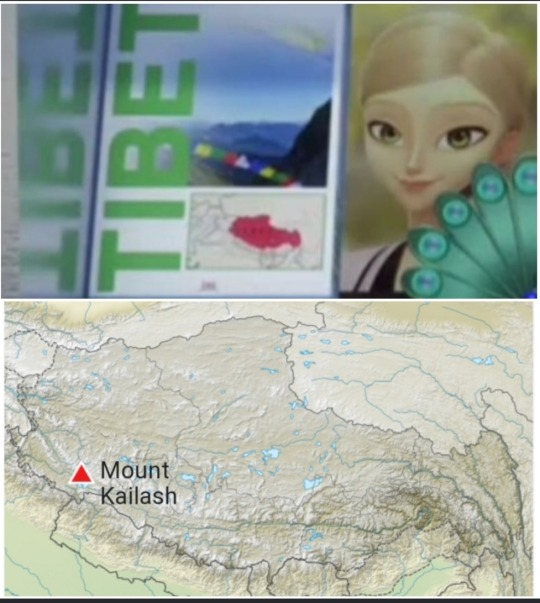
Just like in the show, Mount Kailash is located in Tibet and is part of the Himalaya. Its shape is a bit tricky to compare but even if it wouldn’t add up I think it wouldn’t matter that much. As long as the Ml mountains shape isn’t completely off and unrecognizable let a mountain be a mountain, the shape is not what’s most important about it anyway (not in this theory at least). The height on the other hand adds up very nicely. As we see in the flashbacks the guardian mountain may have been up high but also wasn't the highest mountain in the region by far.
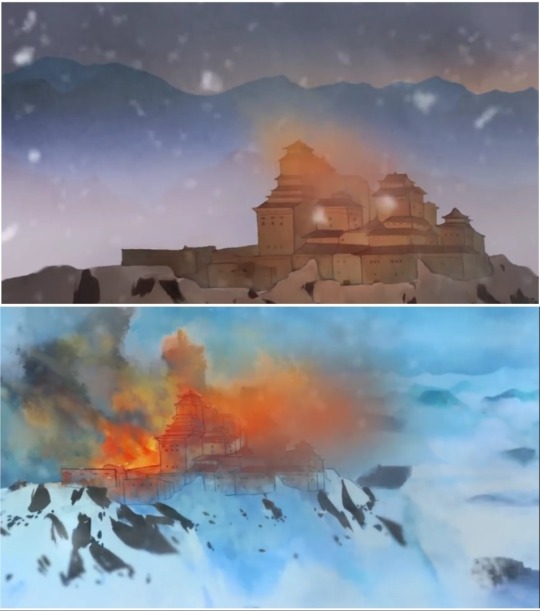
This also applies to Mount Kailash. It is “only” 6,638 m (21,778 ft) high, which is small in comparison to several other mountains that go up to 8,850 metres (29,035 ft). So just like in the show, its not the highest mountain but definitely high enough to sometimes be above a cloud layer.
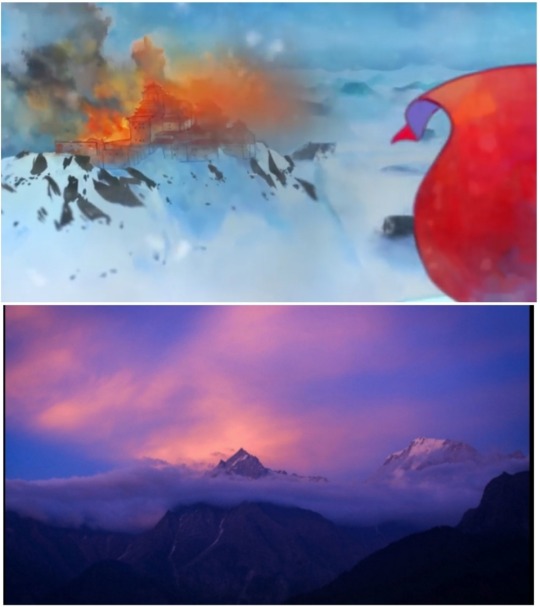
Next is the lake. Just like we saw in Fu’s flashback, mount Kailash also has a lake. Two to be correct. Lake Manasarovar and Lake Rakshastal.
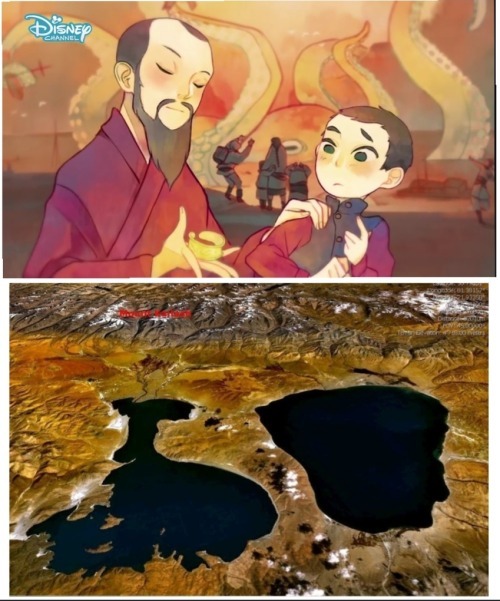
The lake seen in the flashback I believe to be Lake Manasarovar (right)
The lake is located right by Mount Kailash and is believed to be the most sacred one in Tibet and has the most transparent water among all the lakes in China. In Hinduism, Lake Manasarovar is a personification of purity and bathing in it and drinking its water is believed to cleanse all sins. That sounds definitely like a perfect fit for the ancient, mystical guardian mountain lake we are looking for here.
Of course, the show hasn’t given us any indications yet that the mountain lake has such a high status (how could it? We saw it in one picture) and for all it is, the one in the show doesn’t have to. If the lake(s) end up having such qualities as well (which I believe and I’m also convinced the second lake will be of great importance as well but all of this is an extended theory for a very different day) than that’s wonderful and I’m more than happy, but if not then I’m convinced as well that it was not just a random lake they put in there but one with a mighty cultural significance.
Beside that, the lake happens to be a fresh water lake. This would also explain how a squid or kraken was shown to us to have been there, since those are freshwater animals.
Next is the whole temple thing in general. In real life there is of course no temple on Mount Kailash, but this doesn't mean that the concept of a temple for this mountain is anything new. In fact, it's really, totally, utterly not. There may be no temple on our mountain but we still do have a Kailasa temple and MY is this one important as well!
Comparing these two makes it quite obvious right away, they do have big differences. The material, the design etc. But once again, inspiration doesn't mean copy paste.

What caught my attention here were for example the big stone circle in the middle that mirrors the guardian symbol and the big tower right beside it reminds of the biggest building from the guardian temple. While the Kailasa temple is not built on Kailash, it's shape is supposed to reflect and honor the mountain because the temple was built for the greatest of the hindu gods, lord Shiva (the main God who is supposed to life on top of kailash's peak) and therefore it was supposed to resemble his home.
Meaning what Miraculous did here in my opinion, is that they simply combined Mount kailash and the Kailasa temple to make their own version for the show that is unique enough to stand on its own but also stays close enough to its roots to properly honor and portray them.
I LOVE this.
(Okay I'm gonna take this little section to gush a little about this temple because my GOSH this temple is a beauty to behold!
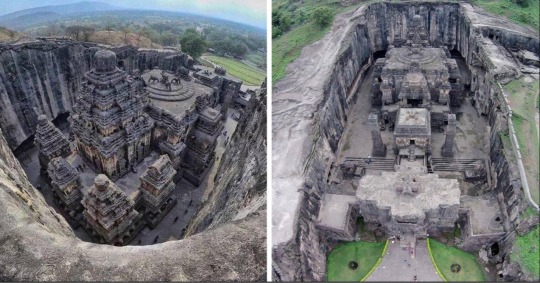
You are not just looking at any temple here, all of this was CARVED out of the stonewall in ONE PIECE! This is one of the greatest architectural masterpieces in human history and today no one can actually tell how the ancient local people even DID this.

I mean LOOK at this! This is of pure stone, all in one piece and there is even a gigantic underground section!
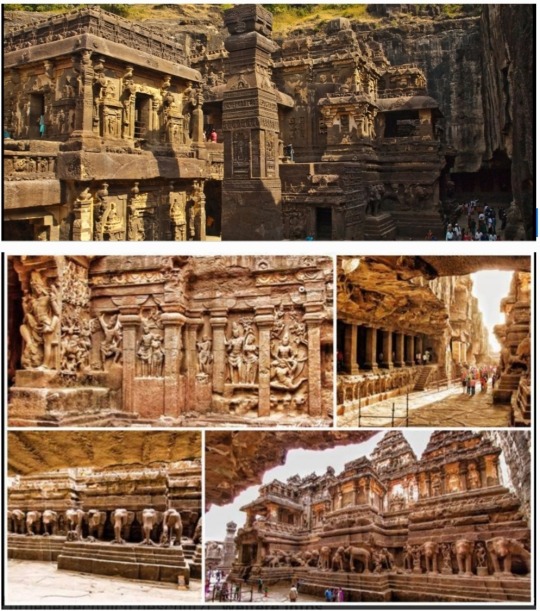
And each and every wall is full of smaller carvings from the bottom to the top, telling the stories of their culture, their mythology and believes. And even those are little pieces of art for themselves! This is marvellous! I hope that one day I will be able to see this place in person because... wow!)
Alright, leaving the materialistic basics behind us, lets take a look at its religious and cultural significance and its mystical reputation because those are *chef kiss* just beautiful.
Here is an important thing to keep in mind that since the Miraculous mountain is not going to be straight up real life Kailash, only inspired by it, this also means the show would be able to include some of its myths and folklores a lot more directly. Therefore I’m also including them here in my theory.
Coming back to what I said earlier, that apparently Mount Kailash is the holiest mountain on earth. And well, that's no exaggeration of mine. Mount Kailash is the center point of 4(!) religions, Buddhist, Hindu, Jain and Tibetan Bön. These religions also make the fact that the guardians are portrayed as monks a perfect fit. The fact that Mount Kailash has such an immense significance for the regional religions also led to one of the greatest check points for this theory:
Mount Kailash is to this day unclimbed. For several reasons I will cut down to the 3 most important for my theory:
1. As Mount Kailash is believed by 4 religions to be the center point/or a place of great significance, it is also a place that people hold in alot of honor, respect and fear as well. It's peak is believed to be place were their gods rest and/or where basically the divine energies of Existence are residing and therefore you don't just CLIMB that mountain.
Regional people and believers go an incredibly long way to honor it even to this day and therefore, no, regional people never dared to claim this mountain for themselves and its forbidden by the law to dishonor this sacred place by doing so. Bringing this back to miraculous I’m sure you already see why this fits like a glove.
If there is any real life mystical mountain the guardians of the miraculous would be located on, it's this one! The Miraculous are the origins of the in-universe world and as we know from Fu it is an unspeakable honor to be chosen as one of their guardians. The guardian society was/is located off of the normal society and at least the local people from Fu's childhood knew of their existence. Meaning here again, the miraculous mountain as well holds a great cultural significance and only the chosen guardians were allowed to climb it but for that they also had to dedicate their lives to the miraculous and life in isolation from the rest of the world.
This in combination with:
2. When I say it is forbidden to climb that mountain I mean FORBIDDEN. Not only by regionals and believers because of religion reasons. No. Between the 50s and the 70s Chinese authorities have officially managed to declare this sacred mountain as off limits, keeping it unclimbed and under protection with all means needed. Meaning no climbing by foot (beyond the free area that has always been allowed) or by any machine. It's peak is to be remained untouched. And this also means any footage taken from the mountain needs to be done from far away, no matter how ouf of the world the happening on the mountain may be. And that's precisely what we saw in "Feast"

One would think that the reappearance of a long-lost temple on a fuck high mountain would get the immediate reaction of storming and exploring it like hell. But that's not what's happening here and I don't think it's just for plot convenience at all. If we are indeed talking about a mountain in miraculous here that is just as protected by the law as mount Kailash in real life, then THIS reporting here is as close as anyone can officially/legally get in that moment without serious consequences with the law and Chinese government.
They didn't NOT storm the temple because of plot reasons, they didn't because they are legally aren't allowed to set foot on a sacred unclimbed mountain that is supposed to stay that way. What a great and subtle way of telling us more and more about the significance of the guardian mountain. Wonderful Miraculous, I applause you ^^
But there is still another reason why Mount kailash's unclimbed status convinced me that this is indeed the mountain we are (at least in an inspired way) being presented with in the show.
My point 3. is the reason why Kailash remained unclimbed by (the native) people in the first place which highly influenced its immense religious status although history to the point where it is believed to be the center place of GODS, THE ENTIRE UNIVERSE and ALL OF EXISTENCE.
Cause its not like no one ever tried to climb it. Naturally people did, just like with any other mountain on earth. But here is the thing: somehow no one was able to actually DO it. Odd how humans were and are able to reach the peak of freaking Mount Everest even though it's ALOT higher and objectively deadlier by a long shot but "small" and "easy" Kailash is the one still unclimbed.
Kailash didn't get its godly, mystical and fear-striking reputation for no reason. We are now officially stepping into folklore and myth terrain which is actually exactly what we are looking for because a show called "Miraculous" is going to REGALE in the supernatural stories of its influences. And when I say supernatural, I do indeed mean SUPERNATURAL. The climbers who survived their trip reported of unearthly happenings and situations that made claiming Kailash simply impossible. I'm not sure if saying Kailash seems to have a mind on its own is appropriate but it surely seems to try to defend itself from people who aren't worthy or not supposed to be there with means from another layer of existence.
Sudden weather extremes that come out of nowhere to stop the mountaineering and a seemingly changing environment that leads the climbers into confusion, the wrong direction (away from the peak) and even their end are two of the greatest examples and they fit perfectly into the nature of the Miraculous.
Another myth I’ve read quite a lot about is that on Mount Kailash time works… differently.
This also goes back to its defence mechanism of intruders because it is said that trying to climb it will let hair, nails etc grow a lot faster or fasten up the aging process all together to the point were relatively young climbers died the very next year of freaking OLD AGE! This is not only interesting for the miraculous mountain because it’s a supernatural coping mechanism of the Miraculous origin place using a power we are already familiar with (Bunnix time powers) but also because Kailash’s very same time anomalies are also said to grand a longer life (to those who are worthy if I’m not wrong). And do tell, what’s Fu’s age again? That’s right, a very impossible 186.
BUT, when the Miraculous guardian mountain does grand those who are chosen to be guardian (probably through a ritual or something like that to ultimately seal their “decision” to dedicate their lives to the Miraculous) a much longer life through its magical nature, that would definitely make Fu’s age much more plausible.
And yet still, even after everything I brought up one can still raises the questions “Yes but why THIS mountain? What’s so special about it that all of the miraculous things would happen there? Real-life and Miraculous. For all it is, is it just a coincidence?”
You all know me well enough by now that NOPE, I’m sure as heck not done yet :D Lets get to my last point and this one is what sold this entire idea to me 100%, without a single doubt left behind. This is the HEART of this theory.
Let me explain to you Mount Kailash’s status as Axis Mundi.
Trying to keep this as easy as possible, I do think its concept is comparable to the medieval believe that the earth is the centre of the universe. That everything from the sun to every known planet circles around us and we were the first and most important thing created. Axis Mundi is somewhat like this.
Axis Mundi means “earth axis” in latin and is basically the center point of the earth. It has several ways to approach its meaning from religion, astrology to geography. Good thing for us, Mount Kailash is a complete jackpot in this regard, so this makes it easy! (This is probably the reason why Kailash is seen as THE Axis Mundi for many people, even if there are several others that fit under certain categories as well)
Astrologically Mount Kailash is an Axis Mundi because of its location between the two celestial poles. Its distance to the north pole is 6666km and to the south pole LITERALLY the double: 13332km. Its wild, but it gets even better!
The geographical point of view only supports the astrological because Mount Kailash is said to be part of a several-linked-monuments-line with the exact same km-count of 6666km in between all of them.
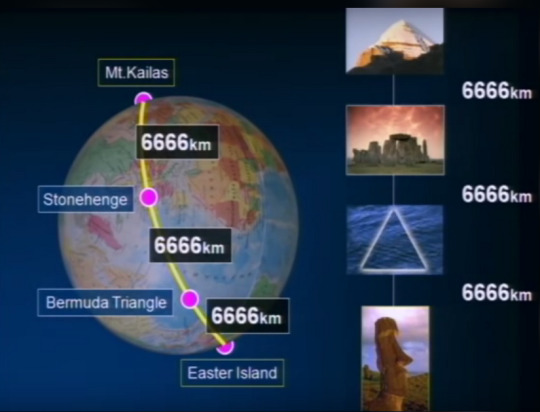
And maybe this is the right time to remind you that the height of Mount Kailash that I have mentioned in the beginning is 6638m.
Although this is a point, I wouldn’t bet my hand on for 100% legitimacy, since when I double checked the Kailash to Stonehenge UK distance on Google Earth, I ended up with a distance of 6.900-something km. But at the same time the measurement system there can get quite off in such mountainy terrains so that doesn’t mean its officially wrong. Just in question. Luckily it isn’t even that important if this is true or not in real-life, because even if it isn’t, then Miraculous as a TV show can still incorporate and work with this myth/conspiracy(?) no problem.
Another geographical but more local reason for why Kailash is seen as Axis Mundi in China is because there 4 main Asian rivers find their source: Shiquan (Lion!) river, Maquan (Horse!!) river, Xiangquan (Elephant) river and Kongqu (Peacock!!!) river. now that’s something to keep in mind in future. Each on one of the 4 sides of the mountain, making it indeed a source of life for all of China and therefore a “center point” as well.
And last but definitely not least and my, this one if my favourite!
As I explained earlier, Mount Kailash is seen by 4 religions as the center place of their gods, the entire universe and all of creation. But not only that. Because since it is the place where literal gods can manifest, it is also the place where our material world meets the spiritual one and they overlap (Hence the supernatural nature and abilities of the mountain).
Do you see what this means for Miraculous?
It means that the guardians didn’t chose their mountain by sheer coincidence. It means that this very mountain peak is the place where humans where/ARE able to get access to the Kwamis!
A while ago Thomas Astruc posted this on Twitter

He describes the nature of the Kwamis as not actual living creatures per se but more like the embodiments of abstract concepts found in this universe’s existence. Humans can only interact with them through the ml jewelleries but even if these get destroyed (bee miraculous in “Queen Wasp”) the Kwami doesn’t “die”, it just goes back to its original abstract (bodyless) form and can be brought back with their Miraculous because, logically, destroying the bee miraculous for example didn’t wipe out the entire concept of Submission. Duh. Therefore, Pollen was still “there”.
So if the Kwamis are more embodiments of abstract concepts which need a specific item to physically materialize in the, well, MATERIAL world then this means there needed to be a place of transition between these two layers of reality to seal the Kwamis to the Miraculous’ in the first place. And BOY, this is it!
I’m so convinced that the guardian mountain is the Miraculous inequivalent of our Mount Kailash, everything fits like a glove and explains so many questions I haven’t even considered to ask before now!
Especially the last part about the origins and nature of the Kwamis and how their transition into the real world happened is such a gigantic lore aspect! There is so much to be discovered and connected here and I’m already reworking everything about the lore I have so far and MAN I’m glad I picked up on theorizing about Ml again! I am EXCITED!
But for now, this is it :D
#miraculous#miraculous ladybug#ml theory#guardians of the miraculous#ml tibet#kwamis#ml spoilers#ml feast#ml season 3#ml guardian mountain#Mount Kailash#Kaisala temple#ml master fu#ml sugar
238 notes
·
View notes
Text
Distinguished Educationists and Media personalities honoured on Teacher’s Day eve
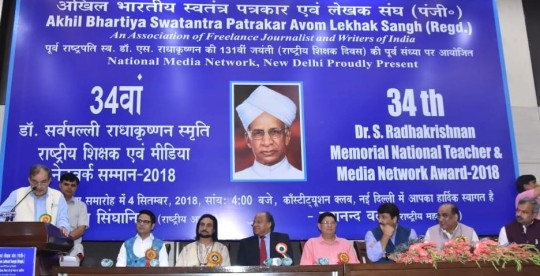
Eminent educationists and media personalities were honoured with the prestigious Dr S. Radhakrishnan Memorial National Teacher and Media Network Award- 2018 at the Constitution Club of India on 4th September’2018. The Award program organized on the eve of Teacher’s Day under the aegis of Akhil Bhartiya Swatantra Patrakar Avom Lekhak Sangh (An Association of Freelance Journalists and Writers of India) was the 34th event in succession. This year’s event coinciding with the 131st Birth Anniversary of former President of India Dr. Sarvapalli Radhakrishnan was graced by the presence of Union Minister of Steel Ch. Birender Singh who was the Chief Guest. The award function was inaugurated by Ambassador of Venezuela in India H.E Augusto Montiel and Santoor Maestro Padam Shree Pandit Bhajan Sopori.
Notable among the distinguished personalities who graced the event and honoured the awardees were Manoj Tiwari (Delhi BJP Chief and MP), Rakhi Birla (Deputy Speaker of Delhi Vidhan Sabha). Adesh Gupta (Mayor of NDMC), Dr Yoganand Shastri (Former Speaker of Delhi Vidhan Sabha), Dr Narender Nath (Former Education Minister), and Devender Yadav (AICC Secy and Co- Incharge Rajasthan).
Prem Singhania (President) and Dayanand Vats (National General Secretary), the two pillars of Akhil Bhartiya Swatantra Patrakar Avom Lekhak Sangh played the perfect hosts and the organizers.
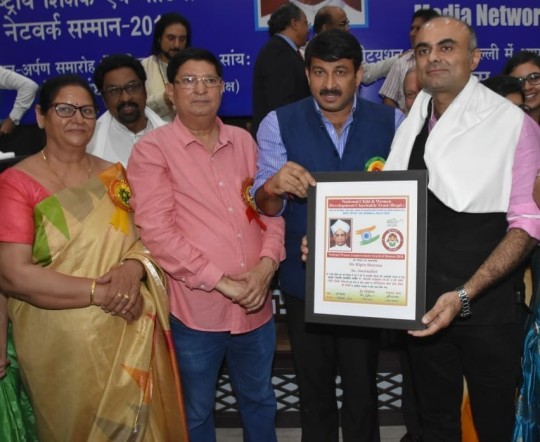
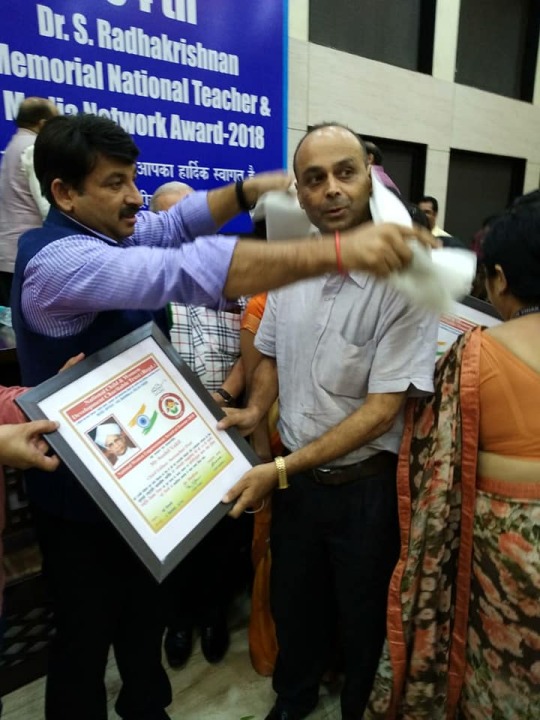
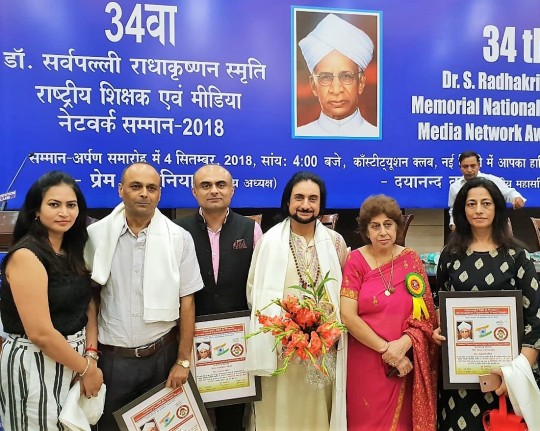
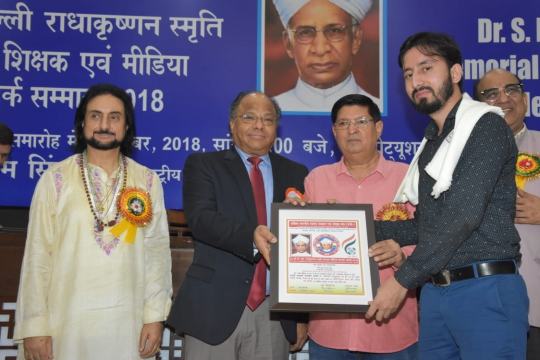
At the glittering function organized at the Constitution Club of India, educationists and media personalities who were felicitated included names like senior journalists Sushil Vakil, Bipin Sharma and Sunita Vakil, Anjeet Srivastav (Anchor, News Nation), Dinesh Kandpal (Sr Producer, India TV), Devendra Sharma (Business Editor, Rastriya Sahara), Bhawna Gulati Nayar (Sr Producer, Anchor, Lok Sabha TV), Sheerin Siddiqui (Sr Anchor, Sr Producer, India News), Puja Shukla (Sr Anchor/ Correspondent, Delhi NCR, Total TV), Saumya Pandey (Young Documentary Maker), Syed Suhail (Sr Anchor, News 24), Garima Sharma (Freelance Journalist), Sabeena Tamang Deshmukh (Sr Producer, Anchor, Reporting Manager, Zee Hindustan), Hemwati Nandan Rajoura (Sr Correspondent, Hindustan), Yogender Mann (Director, Press & information, NDMC & East MCD), Pradeep Mahajan (Chairman, INS Media), Shah Faisal (Assistant Manager, Hindustan Times & Sr Group Leader, HT Media), Dr Sorabh Malviya (Astt Prof, Makhan Lal Chaturvedi Rashtriya Patrakarita Vishwa Vidyalaya Noida Campus), Yogesh Sharma (Chief Editor, Parichay Times Hindi Daily), Rajan Sharma (Sr Correspondent, Hindustan), Pradeep Srivastava (Sr Special Correspondent &HOD, Guest Relation, NewsX, ITV Network), Narender Bhandari (Principal Editor in Chief IPPCI Media. Org.), Digpal Singh, Chief Sub Editor, Jagran.com, Anant Paliwal, Chief Copy Editor, Amar Ujala. Com, Harjeet Prakash, Chief Editor, Uday Prakash Newspaper, Sumitra Goel, Principal, J.R Media Institute, Punjab Kesari, Delhi, Vijay Sant, Crime Reporter, Good Evening Delhi, Anamika Amber, Deligate, Parliament Press of South Asia, M.P Chapter, Ravindra Kumar Tanwar (Lecturer, HOD Fine Art) Delhi Police Public School, Safdarjung Enclave, New Delhi, Pandit Vijay Shanker Mishra (Musicologist, Music Critic, Writer, Teacher), Anurag Singh ( Sangeetacharya & Musician- Vichitra Veena Player) Music Teacher, DAV Public School, Kailash Hill, New Delhi, Ghulam Abbas Khan ( Eminent Hindustani Classical Singer & Composer ), Mridu Marwah (Sr Biology Teacher, Bal Bharti Public School, Sector-10 , Rohini, Delhi), Nipun Soin ( Eminent Art Curator) Director, The Allure Art & Event, New Delhi, Dr Jaswinder Singh (Principal) SGTB Khalsa College, Delhi University, Dr Swati Pal (Principal) Janki Devi Memorial College, Delhi University, Dr Manoj Sinha (Principal) Arya Bhatt College, Delhi University, Prof Hansraj Suman, Member Academic Council, Delhi University, Vandana Jha (Principal) Neo Great Mission Public School, Sector-5, Dwarka, New Delhi, Dr Deepika Sharma, (Lecturer) Great Mission Teacher’s Training Institute, Sector- 5, Dwarka, New Delhi, Tushar Mittal (TGT. Work Exp) Kendriya Vidyalaya N.2, APS Colony, Delhi Cantt, New Delhi, Sunita (Lecturer History) Joga Singh Khalsa Girls SSS East Patel Nagar, New Delhi, Arjun Singh (TGT Math) Mount Abu Public School, Sector-5, Rohini, Delhi, Dr Vivek Gautam (Lecturer English) Govr Co-Ed SSS Chilla Village, Mayur Vihar-Ph-1,Delhi, Seema Malhotra (Principal) Manav Rachna International School , Faridabad, Haryana, Gyan Sagar Mishra (Lecturer History) School of Excellence, Sector-17, Rohini, Delhi, Dr Jyotsna Sharma (Principal) Shambhu Dayal Global School, Dayanand Nagar, Ghaziabad, UP, Bimlesh Jha (Principal) DAV Centenary Public School, Narela, Delhi, Geoff Lyonel Jonathan (CEO) Apex Public School, Sant Nagar, Burari, Dr Nicky Dabas (Founder President, Nutrition & Natural Health Sciences Association, Delhi), Dr Deepali Bhalla, Manager, Little Flowers Puhlic School, Vijay Park, Yamuna Vihar, Delhi, Bhavna Arora (HOD, Social Science) Little Flowers International School, 100 ft Road, Shahdara, Delhi, Shanta (PRT) SLS DAV Public School, Mausam Vihar, Delhi, Payal Ahuja ( PRT Science) SLS DAV Public School, Mausam Vihar, Delhi, Harpreet Kaur Chera, Asst Teacher, Bosco Public School, Sunder Vihar, New Delhi, Vibha Khosla, Principal, Shri Ram School Delhi West, Tikri Kalan, Delhi, Bhavna Sawnani, Mentor Teacher, TGT Natural Sciences, RPVV, Thyagraj Nagar, New Delhi, Kiran Khullar, Supervisory Head, DAV Public School, Phase 4, Ashok Vihar, Delhi, Hemant Kumar Jha, Principal, Aryans International School, Buddhi Vihar, Moradabad, U.P.
Those honoured with the 34th Dr S Radha Krishnan Memorial National Medical Teachers Awardees 2018 included stalwarts like Dr. B D Athani (Principal Consultant, DGHS, MoHFW, Professor, Physical Medicine and Rehabilitation, VMMC & Safdarjung Hospital, New Delhi), Dr. Beeva Boruah (Professor & Head, Department of Community Medicine, Fakhruddin Ali Ahmad Medical College, Barbeta, Assam), Dr Ganesh Govekar (Professor and Head Forensic Medicine Government Medical College, Surat Gujarat), Dr. Appala Naidu Sambangi (Professor and Head, Department of Social & Preventive Medicine Registrar, Dr.NTR University of Health Sciences, Vizag, Andhra Pradesh), Dr Hemlatha (Professor & Head, Department of Preventive & Social Medicine Chattisgarh Institute of Medical Sciences (CIMS), Bilaspur), Dr Sujeet Kumar Singh (Director, National Centre for Disease Control, DGHS, Delhi), Dr Asim Das (Dean, ESCI Medical College, Faridabad, Haryana), Dr. Charan Singh (Director, Rural Health Training Center, MoHFW Govt of India, Najafgarh, Delhi), Dr. Adesh Kumar (Professor & Head, Department of Respiratory Medicine, UP Medical University Safai, Etawah UP), Dr Ali Amir (Professor & Chairman, Department of Community Medicine, JN Medical College, Aligarh Muslim University, Aligarh UP), Dr. Pratap Kumar Jena (Associate Professor, School of Public Health, KIIT, Campus-5 (KIMS), Patia, Bhubaneswar, Odisha), Dr. Sonia Puri (Assistant Professor, Department of Community Medicine, Govt Medical College & Hospital, Chandigarh), Dr. Abhay Singh (Assistant Professor, Department of Community Medicine, GSVM Medical College, Kanpur, UP).

Speaking on the occasion, Dayanand Vats, General Secretary of Akhil Bhartiya Swatantra Patrakar Avom Lekhak Sangh said, “Our 34 year long journey has not been without hard struggle and tough challenges. Thanks to the untiring efforts, sincerity and the zeal of our core team members that Dr S. Radhakrishnan Memorial National Teacher’s and Media Network Award is not only regarded as the most credible, but also as one of the most coveted Awards in the country. The Awards are given every year to meritorious personalities who have excelled in their respective fields. The winners have exemplified excellence among their peers in respective sector and regions. These awards intend to inspire others towards bigger achievements. Like every year, a Shawl, Memento and a Certificate of appreciation were given to the Awardees.”
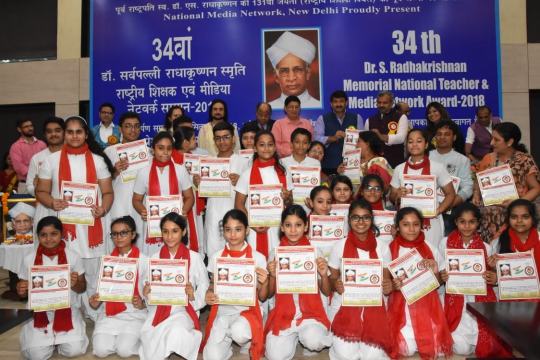
Distinguished personalities while hailing the role of Media and Educationist also urged them to play a more pivotal role in Nation Building by being ‘Role Models’ for the youth brigade.
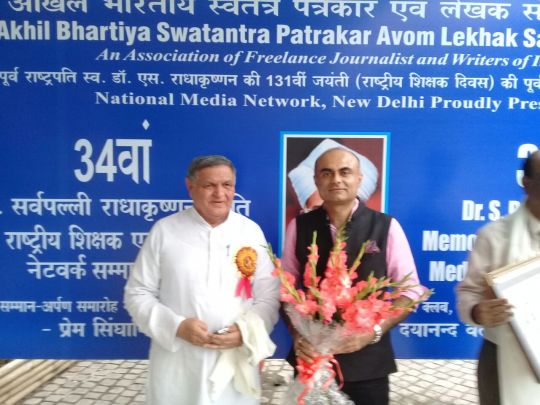
In his brief speech, Dr Yoganand Shastri said, “It is incredible that Akhil Bhartiya Swatantra Patrakar Avom Lekhak Sangh has been organizing and hosting the excellence awards in the field of education and media since the past 34 years. The distinctive aspect about their program being how they manage to introduce a novel component into these awards every year. Dr S. Radhakrishnan Memoral National Teacher’s and Media Network Award conferred on outstanding achievers by their organization has indeed been playing a crucial role in inspiring the brilliant achievers in various fields to scale even bigger heights. Educationists have a key role to play in the society which is why they are respected universally and remembered all their lives for their role in character building and holistic development. Teaching is unquestionably noblest of all professions.”
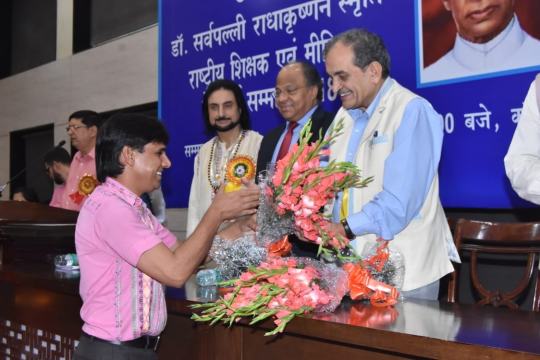
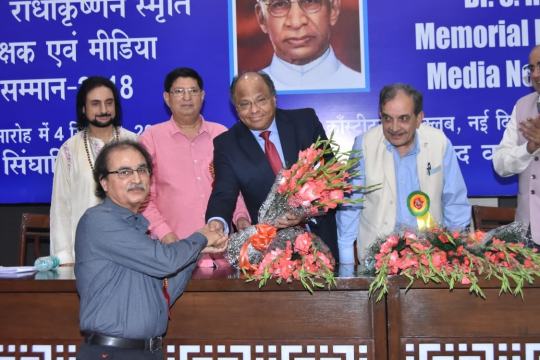
Feeling delighted with the honour, Sunita Vakil said, “Any award or honour is a recognition of the hard work and passion involved. Special gratitude to the jury that chose me to be one of the recipients of this special honour. The Award means a lot to me since it is an appreciation of my efforts.”
The awards ceremony was followed by tea and light snacks.
0 notes
Text
Famous work of sculpture : : Site
Famous work of sculpture : : Site
With reference to the Indian history of art and culture, consider the following pairs:
(Famous work of sculpture) : : (Site)
Ravana Shaking Mount Kailash : : Ajanta Descent of Ganga : : Mahabalipuram Huge image of Varaha Avatar (boar incarnation) of Vishnu : : Udayagiri Which of the pairs given above is/ are correctly matched?
a 1 and 2 only b 1 and 3 only c 2 and 3 only d …
View On WordPress
0 notes
Text
The prime worship of Lord Shiva is through the worship of Shiva Linga. Any other worship is secondary. The light of God “Jyoti Swarupa” exist in all the Shiva Linga forms. There are renowned 12 jyotirlingas across the world, each held with great esteem since the ancient times. Even the old Puranas glorify the abodes and talk in details about how devotees are pulled towards these kshetras due to the divine presence in these devodes.
What is jyotirlinga ?
A Jyotirlinga is a shrine where Lord Shiva is worshipped in the form of a Jyotirlingam. Now you would ask what a Jyotirlingam is? It is the radiant sign (phallus symbol) of The Almighty.
It is believed that Lord Shiva first manifested himself on Earth on the night of the Aridra Nakshatra, thus the special reverence for the Jyotirlinga. There is no unique appearance to mark the Jyotirlingas. Many people believe that you can see these lingas as columns of fire piercing through the earth after you reach a high level of spiritual attainment. Originally there were 64 Jyotirlingas out of which 12 are considered to be highly auspicious and holy.
Among the twelve Jyotirlingas, two are spread across the sea shore, three on the river banks, four in the heights of mountains and three in villages located in meadows. Anyone who goes to the temple receives the holy blessing of Lord and come back as happy, peaceful and blessed.
1. Somnath Jyotirlinga, Saurashtra, Gujarat
सौराष्ट्रे सोमनाथं च श्रीशैले मल्लिकार्जुनम्। Saurāṣṭre Somanāthaṃ ca Śrīśaile Mallikārjunam
Considered to be the first of the 12 Jyotirlingas, the Somnath Temple in Gujarat is situated near Veraval in (Prabhas Kshetra) Kathiawad district. One can find many references of this temple in the Puranas, as well as, the Itihas, “history”. Moreover, Somnath, also known as Prabhasa Kshetra, holds a much-esteemed place for Hindus. Back in the days, the inner temple was supported to be aglow with the lustre of gemstones, with Nanda Deep kept lighted with Kannauji attar. One can say, the temple was a treasure.
There is a legend related to how this Jyotirlinga came into being. According to the Shiva Purana, the moon was married to 27 daughters of Daksha Prajapati, out of which he loved Rohini the most. Seeing his negligence towards the other wives, Prajapati cursed moon that it would lose all its radiance. A disturbed moon along with Rohini came to Somnath and worshipped the Sparsa Lingam after which he was blessed by Shiva to regain his lost beauty and shine. On his request, Lord Shiva assumed the name Somchandra and resided there eternally.
This is also considered to be the primary of all the JyotirLingas as it is considered to be Swayambhu (self-birth) and is always awake with hundreds of thousands of devotees visiting the temple every year.
2. Mallikarjuna Jyotirlinga, Srisailam, Andhra Pradesh
Built around 1234 AD by the Hoyasala king, Vira Narsimha, Sri Mallikarjuna Jyotirlinga is located in Kurnool district of Andhra Pradesh, an area full of forests of Kadali, Bilva trees, mountain ranges and Patalaganga (Krishnaveni river). This river is in the form of underground spring, and this is where millions of devotees take the holy dip and go to worship the Jyotirlinga.
It is also known as “Kailash of the South” and is one of the greatest Shaivite shrines in India. The presiding deities at this temple are Mallikarjuna (Shiva) and Bhramaramba (Devi).
According to the Shiva Purana, Lord Ganesha was married off before Kartikeya which left Kartikeya angered. He went away to the Kraunch Mountain. All the Gods tried to console him but in vain. Ultimately Shiva-Parvati themselves travelled to the mountain but were turned away by Kartikeya. Seeing their son in such a state they were very hurt and Shiva assumed the form of a Jyotirlinga and resided on the mountain by the name of Mallikarujna. Mallika means Parvati, while Arjuna is another name of Shiva. It is believed by the people that just seeing the tip of this mountain one is emancipated of all sins and becomes free from the vicious cycle of life and death.
History recounts when Chatrapati Shivaji used to take a “Darshan” of the JyotirLinga during the Maharatri, and he also built a tower on the right side of the temple, opening a free meal center. Other kings of Vijayangar Dynasty have built the temple, tower, portico, and a pond too. Before it was difficult to reach because of terrain, yet many devotees have reached there with their sheer will-power. This includes the mythological personalities like Hiranyakashipa, Narada, Pandavas, Sri Ram.
3. Mahakaleshwar Jyotirlinga, Ujjain, Madhya Pradesh
उज्जयिन्यां महाकालमोङ्कारममलेश्वरम्॥ Ujjayinyāṃ Mahākālam Omkāram Mamleśhwaram
This temple lies in the city of Indrapuri Amaravati and Avantika, known as the “Swarna Sringa” because of the number of golden towers of several temples in the city. Mahakaleswar is grand and is also known for the foundation of Adyapeetha, the foundation of Sanskrit learning, ethics, knowledge or science, and art. It is said that those who visit Mahakal temple will never be touched by sorrows, even in the dreams, and those who pray to the Mahakal would be granted all the wishes.
According to the Puranas, there was a five-year-old boy Shrikar who was enthralled by the devotion of King Chandrasena of Ujjain towards Lord Shiva. Shrikar took a stone and started worshipping as Shiva. Many people tried to dissuade him in different ways, but his devotion kept growing. Pleased by his devotion, Lord Shiva assumed the form of a Jyotirlinga and resided in the Mahakal forest.
The other mythological stories which is most frequently heard is that Lord Shiva appeared in Ujjain from the ground to vanquish a demon called Dushana whose tortures on the people and Brahmins of the Ujjain city, had crossed all the limits. After killing the demon, Lord Shiva took the form of Jyotirlinga and since then, he has been residing in this holy city
4. Omkareshwar Jyotirlinga, Shivapuri
The word Omkareshwar means “Lord of Omkaara” or the Lord of the Om Sound!
सप्तजन्मकृतं पापं स्मरणेन विनश्यति॥ saptajanmakṛtaṃ pāpaṃ smaraṇena vinaśyati
This temple is self-born and thus is known as Swayambhu linga. Across the mountain range of Madhya Pradesh, river Narmada flows rippling from the mountains where smooth, round pebbles, known as BanaLingas, are found. On the bank of the river, this temple lies in a huge island.
The island and the river themselves are shaped like “Om” naturally. Devotees feel blessed when they go to the temple as they are doing the parikrama of Om themselves when they visit the temple.
Once upon a time there ensued a great war between the Devas and Danavas (Gods and Demons), in which the Danavas won. This was a major setback for the Devas who then prayed to Lord Shiva. Pleased with their prayer, Lord Shiva emerged in the form of Omkareshwar Jyotirlinga and defeated the Danavas
5. Vaidyanath Jyotirlinga, Deogarh, Jharkhand
परल्यां वैद्यनाथं च डाकिन्यां भीमशङ्करम्। Paraly Vaidyanāthaṃ cha Ḍākinyāṃ Bhīmaśhaṅkaram
It is located in Deoghar in the Santhal Parganas division of the state of Jharkhand, India. According to Shiva Mahapuran, the location is identified as “Chidabhoomi”, which could be the ancient name of Deoghar, and there are references to “Baidyanatham chitabhoomau”. The place also celebrates Krishna festival, despite being a Shiva temple. It is built with stones on a high mound and is surrounded by strong walls on all four sides. Special prayers are held for Sun God in the temple, as the sun rays falling through the windows shine directly on the Lingamurthy inside.
According to a famous legend, the demon king Ravana meditated and asked Lord Shiva to come over to Sri Lanka and make it invincible. Ravana tried to take Mount Kailash with him, but Lord Shiva crushed it. Ravana asked for penance and in turn was given of the twelve Jyotirlingas on the condition that if it was placed on the ground it would remain rooted to that spot till eternity. While transporting it to Sri Lanka, Lord Varuna entered Ravana’s body and he felt an urgent need to relieve himself. Lord Vishnu came down in the form of a lad and offered to hold the lingam in the meantime. However, Vishnu placed the lingam on the ground and it got rooted to the spot. As a form of penance, Ravana cut off nine of his heads. Shiva revived him and joined the heads to the body, like a vaidya and hence this Jyotirlinga came to be known as Vaidyanath.
6. Nageshvara Jyotirlinga, Darukavanam (Aunda)
एतेशां दर्शनादेव पातकं नैव तिष्ठति। eteśāṃ darśanādeva pātakaṃ naiva tiṣṭhati
Legend has it that Pandavas came during their Banbas and built a hermitage for themselves at this place. Legends aside, the architectural beauty of Naganath Temple is exquisite. The structure is beautiful too. Built with stones, the temple is oval shaped and is protected with walls around four sides. The Nandi temple is separate from the main temple, however. All in all, 108 Shiva temples and 68 shrines are located around the temple. Also Read : This Vishnu temple in Kerala is the richest temple in the world. Every 12 years, devotees offer Kashi Ganga as Padarpan at the time of Kapila Shashti.
According to the Shiva Purana, a Shiva devotee by the name Supriya was captured by the demon Daaruka. The demon imprisoned her with several others in his capital Daarukavana. Supriya advised all prisoners to chant “Aum Namaha Shivaya” which enraged Daaruka who ran to kill Supriya. Lord Shiva manifested in front of the demon and put an end to him. Thus the Nageshwar Jyotirlinga came into being.
7. Kedareshwar Jyotirlinga, Kedarnath, Himalayas
हिमालये तु केदारं घुश्मेशं च शिवालये॥ Himālaye tu Kedāraṃ Ghuśmeśaṃ ca Śivālaye
This temple is located at the snow-covered area of Himalayas. One can only visit this temple during six months of a year, the rest of the month, the snow, and extreme cold do not permit devotees to enter. As such, the Kedarnath temple remains closed for pilgrims. Due to extreme snowfall of Kartik, the Sri Kedarshwar idol is brought out of the temple after lighting a ghee lamp, “Nanda Deepa” and the temple is closed for the winter. This idol is shifted to the Urvi Math, in the valley. The temple only opens later in Baisakh. People visit here to see the Nanda Deepa, and when they see this, they consider themselves to be blessed.
According to the legends, pleased by the severe penance of the Nara and Narayana – two incarnations of Lord Vishnu, Lord Shiva took up permanent abode in Kedarnath in the form of this Jyotirlinga.
8. Trimbakeshwar Jyotirlinga, Nashik
एतानि ज्योतिर्लिङ्गानि सायं प्रातः पठेन्नरः। etāni jyotirliṅgāni sāyaṃ prātaḥ paṭhennaraḥ
Tryambakeshwar Temple lies on the banks of Gautami, near Nashik in Maharashtra. Unlike other temples, the Lord in the temple’s Grabhagriha is not worshiped with Abhisekha with water (Jalahari). Instead, there is a bottom part of pounding stone, like a hole, where three Lingas shaped like thumbs exist (hence, the name Tryambakeshwara). An orifice above one of the Linga has a constant shower of water, and this is the Linga of Mahesha.
Every 12 years, Kumbhmela is held here at the time of Simhasta. The architecture is beautiful too with beautiful statues carved around the premise.
Gautam Rishi earned a boon from Varuna in the form of a pit from which he received an inexhaustible supply of grains and food. The other Gods were rendered jealous by him and they send a cow to enter the granary. The cow was mistakenly killed by Gautam Rishi who then asked Lord Shiva to do something to purify the premises. Shiva asked Ganga to flow through the land to make it pure. Everyone thus sang praise for the Lord who then resided beside Ganga in the form of Trimbakeshwar Jyotirlinga.
Read more about this here
9. Rameshwar Jyotirlinga, Rameshwaram
सेतुबन्धे तु रामेशं नागेशं दारुकावने॥ Setubandhe tu Rāmeśaṃ Nāgeśhaṃ Dārukāvane
This temple is situated on a big island of sand, in the Ramnad district of Tamilnadu. Today, it has been expanded into a large temple and is famous for its typical architecture. One finds it auspicious and pious to take Ganga water to this temple after the pilgrimage of four holy shrines. The ritual goes like this: the person takes holy bath in the Ganga river, takes the Ganga water to the temple and offered to Lord Shiva of Rameshwaram, a sanga from there is then carried to Ganga and immersed there. This makes the ritual complete. A grand Badatra mela/fete is organized on the 15th day of Ashada and during Mahashivaratri.
This Jyotirlinga is closely associated with Ramayana and Ram’s victorious return from Sri Lanka. It is believed that Ram on his way to Sri Lanka stopped at Rameshwaram and was drinking water on the seashore when there was a celestial proclamation: “You are drinking water without worshipping me.” Listening to this Ram made a linga of sand and worshipped it and asked for its blessings to defeat Ravana. He got the blessings from Lord Shiva who then turned into a Jyotirlinga and resided at the place for eternity.
10. Bhimashankar Jyotirlinga, Dakini, Maharashtra
कर्मक्षयो भवेत्तस्य यस्य तुष्टो महेश्वराः॥: karmakṣayo bhavettasya yasya tuṣṭo maheśvarāḥ
The temple of Bhimashankar is built in Hemadpanthi style, embellished with Dashavatar statues, qualities that make the temple very beautiful to look at. One enjoyable thing to do in this temple is the ring the big bell and hear the echo roaming the entire temple. Every day, people worship Bhimashankar with Rudrabhishek, Panchamrit snan. The temple is flooded during Mondays and during the Mahashivaratri. Along with the temple, the natural scenic beauty of the temple is wonderful to look at. Moreover, when one enters the River Chandrabhaga (Bhima) on the expansive meadows, one can see a large number of devotees dancing together in a trance.
The legend about the existence of this Jyotirlinga is related to Kumbhakarna’s son Bhima. When Bhima learned that he was the son of Kumbhakarana who was annihilated by Lord Vishnu in his incarnation as Lord Ram, he vowed to avenge Lord Vishnu. He performed penance to please Lord Brahma who granted him immense power. On achieving this power, he started creating havoc in the world. He defeated the staunch devotee of Lord Shiva- Kamrupeshwar and put him in the dungeons. This angered the Lords who requested Shiva to descend Earth and put an end to this tyranny. A war ensued between the two and Shiva ultimately put the demon to ashes. All the Gods then requested Shiva to make that place his abode. Shiva then manifested himself in the form of Bhimashankar Jyotirlinga. It is believed that the sweat which poured from Shiva’s body after the battle is what formed the Bhima River.
11. Visweswar Jyotirlinga, Varanasi, Uttar Pradesh
वाराणस्यां तु विश्वेशं त्र्यम्बकं गौतमीतटे। Vārāṇasyāṃ tu Viśveśaṃ Tryambakaṃ Gautamītaṭe
In the ancient times, Varanasi used to be a beautiful city built in the adjoint of Varana and Asi. This is where kasha, a tribe, used to live, and thus, Varanasi was also known as Kashi. The Ganga here flows in the shape of a bow, and thus there is a special importance for this area and its temple Kashi Visweshwar.
According to Puranas, this city used to be ruled by Brahma, Vishnu, and Mahesha, and this is where even divines want to tie. The present temple we see today was built by Ahalya Devi Holkar in 1777 AD and has the towers covered in gold (as planted by King Ranjit Singh).
12. Grishneswar Jyotirlinga, Devasrovar, Maharashtra
As Madhwamunishwar once said, “Blessed by VerulNagar, there is no other place like it on this earth, where Lord Grishneswara resides, the best place on this earth.”
This last place of the Jyotirlinga, without which the pilgrimage will not be complete, lies in the village of Verul.
According to the Shiva Purana, a couple named Sudharm and Sudeha resided on the Devagiri Mountain. They were childless, and thus Sudeha got her sister Ghushma married to Sudharm. They bore a son who rendered Ghushma proud and Sudeha jealous of her sister. In her jealousy, Sudeha threw the son in the lake where Ghushma used to discharge 101 lingams. Ghushma prayed to Lord Shiva who ultimately returned her the son and told her of her sister’s deeds. Sudharm asked Shiva to emancipate Sudeha which left Shiva pleased with his generosity. On Sudharm’s request, Shiva manifested himself in the form of the Jyotirlinga and assumed the name Ghushmeshwar.
Later Bhosala, very devout Shiva devotee, once found a treasure hidden in the snake pit by the grace of Lord Grishneshwar. As a return, he spent the money to renovate the temple and even built a lake in Shikharshinganapur. Later, Goutamibal and Ahilyadevi renovated the temple. Today, it stands at 240ft X 185 ft, strong and beautiful.
As mentioned in each of the Jyotirlinga, if a person prays those Dwadasa JyotirlInga Strotam during the pilgrimage at each temple, then he will attain salvation and enlightenment, and after death will be released from the cycle of human existence. Worshipping the Lingas will also free people from difficulties and struggle. Darkness eats people and kills them with ignorance.
Jyotirlingas, with its Jyoti “light”, frees people from darkness and the natured light of God fulfills all our wishes
12 Holy Jyotirlinga Temples of Lord Shiva The prime worship of Lord Shiva is through the worship of Shiva Linga. Any other worship is secondary.
0 notes
Link
http://ift.tt/2rrnUuO
There’s something intoxicating about hiking to a distant land where you’re out of your comfort zone face to face with an adventure. Unfortunately, few dare to answer this call and consequently miss out on the experience of a life time. If you are one of the ones who has not embarked on this adventure, we hope that these 25 extremely exotic hiking locations will convince you to do otherwise.
#1 Laugavegurinn Pass (Iceland) Laugavegurinn, il is Iceland’s most popular hiking trail and connects the nature reserves Landmannalaugar and Þórsmörk. The trail offers a great variety of landscape: mountains in almost every color, great glaciers, roaring hot springs, big rivers and lakes. If you decide to embark on this adventure however, come prepared. The full hike takes about four days to complete.
#2 Kungsleden (Sweden) Passing through one of Europe’s largest remaining wilderness areas, is a 270 mile (440 km) hiking trail that is between Abisko in the north and Hemavan in the south. Maintained by Svenska Turistföreningen (STF), hikers can experience Kebnekaise, the highest mountain in the country, Sarek National Park, and several small towns and villages.
#3 Mount Kailash Pilgrimage (Tibet) Mount Kailash is the center piece to four religious pilgrimages: Bön, Buddhism, Hinduism and Jainism. According to the practice, the hike should be done in one full day. However, this is a difficult task since the path around the sacred place is 32 miles (52 km) long and the mountain itself has never been climbed.
#4 Mountains of the Moon (Uganda) Also known as Montes Lunae or the Ruwenzori Range, this mountain range in Uganda makes up the highest ranges in Africa. The total length of the hike is 38 miles and it takes 6-7 days to cover.
#5 Cloud Forests (Costa Rica) There are five cloud forests for you to choose from on your next hiking trip to Costa Rica. There’s La Paz Waterfall Gardens and San Ramon in the Central Highlands, San Gerardo de Dota, Santa Maria de Dota and Bajos del Toro in the Central Highlands. Aside from hiking, there’s also horseback riding, bird watching, a coffee tour and even some guided tours.
#6 Milford Track (New Zealand) If you have seen Lord of the Rings then you already know how this hiking trail in Fiordland National Park looks like (well at least parts of it). Once described as the finest walk in the world, the Milford Track is one of New Zealand’s most popular walks with approximately 14,000 people completing the hike each year.
#7 Kalalau Trail (Hawaii, USA) Hawaii is home to tropical islands, beaches and volcanoes. It’s also home to this challenging trail that runs approximately 11 miles (18km) and takes about a day or two to complete (depending on your fitness level).
#8 Israel National Trail (Israel) Crossing the entire country of Israel, this hiking trail spans 580-620 miles (1000 km). Despite current world issues, this trail gives hikers a taste of Israel’s unique and historical landscape.
#9 Zion Narrows (Utah, USA) Ranked #5 in the National Geographic’s America’s Best 100 Adventures, this hiking trail is a section from the canyon located on the North Fork of the Virgin River. The term “The Narrows” refers to the hike going through the canyon and also the actual place itself which covers 3.6 miles (5.8 km). Wading or swimming through the waist-deep waters can be a challenge for some hikers but is one of the highlights in the entire 16 mile (26km) expedition.
#10 Fitz Roy Trek (Argentina) Cerro Fitz Roy is one of two mountains (the other being Cerro Torre) within Los Glaciares National Park and one of the two favorite hiking destinations in Patagonia. El Chaltén, a small mountain village below the mountain; used to help secure the disputed border with Chile but today, its existence is solely for tourism purposes. The stunning hike also enables you to take a side trip to Perito Moreno Glacier, one of the best attractions on the continent.
#11 Pays Dogon (Mali) Inscribed as a UNESCO World Heritage Site in 1989, Pays Dogon or French for Dogon Country, is a region in south Central Mali and is where the Dogon people have settled in for 1,000 years. Bandiagara, one of the major towns hiking through the smaller villages is one of the popular routes. Visiting this culturally rich plateaus and lowlands would allow you to experience very simple and spiritual way of living.
#12 Petra Kingdom (Jordan) From the Dana Reserve to Petra is a 50 mile hike (which takes approximately seven challenging days). Nevertheless, when you stand in front of the exquisitely carved and fabulously stunning façade of Al Deir , you’ll realize that the arduous hike was well worth it.
#13 Cappadocia (Turkey) Hiking through cave churches and houses carved in the rocks makes Cappadocia in Central Anatolia, Turkey, another culturally rich experience. Several of these underground cities were used by early Christians as hideouts. Other than hiking through all these famous structures, there are also hot air balloon tours and cross golf that you can try out after exploring the scenic cliffs and caves.
#14 The Snowman Trek (Bhutan) It may not be the longest hiking trail on this list, but 24 days away from modern civilization can be challenging in it of itself. Bhutan is known for being a blessed and peaceful place and houses one of the most difficult hikes known to man; the Snowman Trek. What makes this trail particularly challenging is 11 peaks, the highest peak reaching 17,400 feet (~5,303 m).
#15 Great Ocean Road (Australia) The Great Ocean Road is actually the world’s largest memorial dedicated to those who fell during World War I. The 243-kilometer (151 mi) stretch of road along the south-eastern coast of Australia was constructed by returned soldiers from 1919 to 1932.
#16 Annapurna Circuit (Nepal) Spanning 150 miles within the Annapurna mountain range in Central Nepal, this circuit is one of the most popular hiking trails in the world as Nepal is known as the hiker’s mecca. One of the three in this list from this country, the trek takes between from 17 – 21 days to complete.
#17 Mount Kilimanjaro (Tanzania) The highest free standing mountain in the world, Mount Kilimanjaro’s is a stunning 19,341 feet (5,895 m) above sea level. There are six official trekking routes by which someone can climb the mountain. However, if you’re just up for hiking rather than climbing then you can traverse the easier routes.
#18 Great Himalaya Trail (Nepal) Although there have been sections in Nepal and Bhutan that have already been walked on and documented, this 2,796 mile (4500 km) trail is still an ongoing project. It is a proposed route along the length of the Great Himalayan range from Nanga Parbat in Pakistan to Namche Barwa in Tibet, China. It’s projected to be the longest and highest alpine walking track in the world when completed.
#19 Yoshida Trail, Mount Fuji (Japan) Around 300,000 people climb this popular cultural destination in Japan from July to August. Though it is a natural site, the Japanese consider it as a holy mountain along with Mount Tate and Mount Haku. It has been submitted to become a World Heritage site because of its relevance in the country’s cultural history.
#20 Yunnan (China) This mountainous province and an exotic hiking location in China boast a fusion of cultural, historical and environmental diversity. It is riddled with lakes, rivers, rice terraced mountains, national parks, and three UNESCO World Heritage Sites, two of which are natural sites and the other one is a cultural site. The popular Tiger Leaping Gorge is one of its popular hiking spots.
#21 North Drakensberg Traverse (South Africa/Lesotho, uKhahlamba/ Drakensberg Park) The Drakensberg is the highest mountain range in South Africa, crowned by the “Amphitheater” which is a three-mile-long up-to-3,280-foot-high wall of rock. The range forms the border between South Africa and eastern Lesotho. Moreover, the uKhalhlamba/Drakensberg Park is protected by UNESCO as a World Heritage site.
#22 Torres del Paine Circuit (Chile) One word to describe this popular hiking location: gorgeous. That’s why almost every avid hiker in the world wants to experience this mesmerizing Patagonian sensation. Here, blue glaciers create a vivid dichotomy with the earth, exotic animals–like the guanacos–dot the hillsides, and the mountains themselves take on wild and incredible shapes.
#23 Inca Trail (Peru) The Inca Trail is by far the most famous trek in South America and is rated by many to be in the top 5 treks in the world. The 26 miles (43km) trail combines beautiful mountain scenery, lush cloud-forests, subtropical jungles and a stunning mix of Inca paving stones, ruins and tunnels. To top all this off, the final destination of the trail is Machu Picchu, the mysterious “Lost City of the Incas”.
#24 International Appalachian Trail (USA, Canada, Greenland, Scotland, Spain, Morocco) Although there is already an established international trail which covers 1900 miles (3058 km) there are plans to extend the trail towards Great Britain and North Africa. It currently runs from the northern terminus of the Appalachian Trail at Mount Katahdin, Maine, through New Brunswick, to the Gaspé Peninsula of Quebec, after which it takes bridge crossings to Nova Scotia and Prince Edward Island, a ferry ride to Newfoundland, and then continues to the northern-easternmost point of the Appalachian Mountains at Belle Isle, Newfoundland and Labrador.
#25 Mount Everest (Base Camp Trek, Nepal) Mount Everest towers above the Khumbu at over 29,000 feet and is perhaps the most iconic symbol of challenge and adventure on Earth. At the base of the mountain, you can stand face-to-face with the fabled Khumbu Ice Fall and its towering seracs. You can also hike to the summit of Kala Patar at over 18,100 feet for an unobstructed view of Everest’s windblown summit.
Source: List25
0 notes